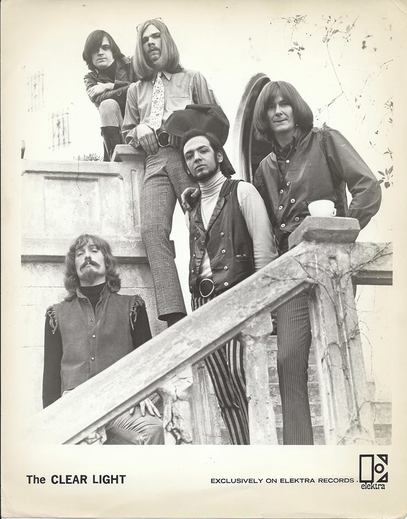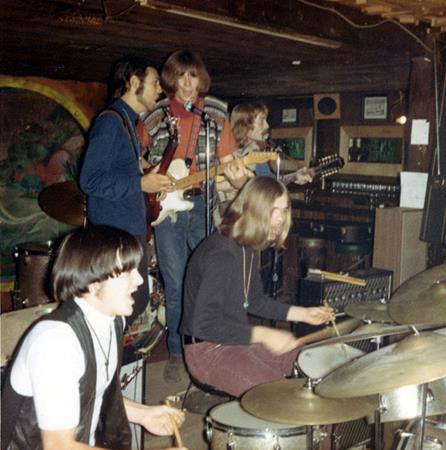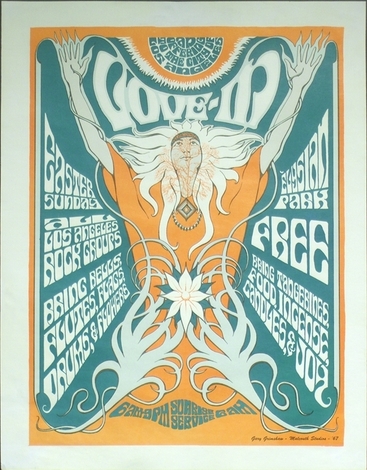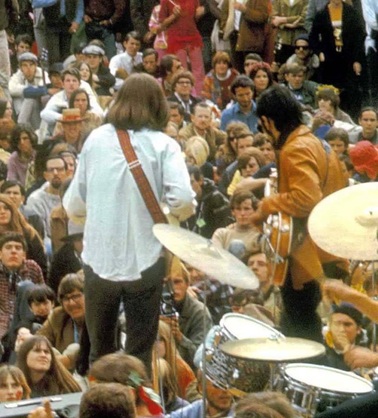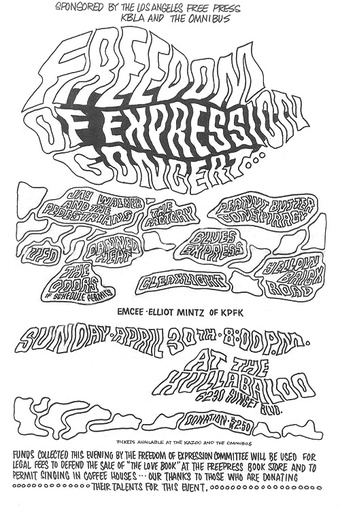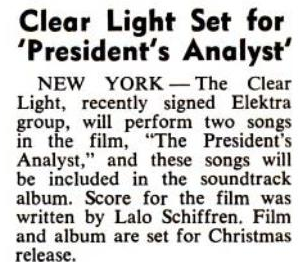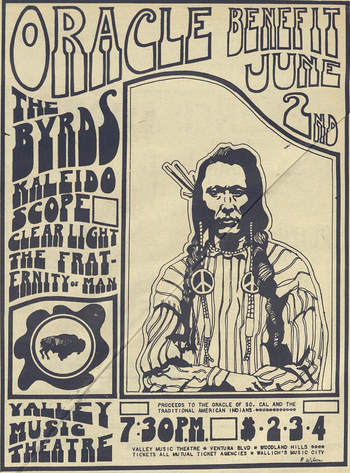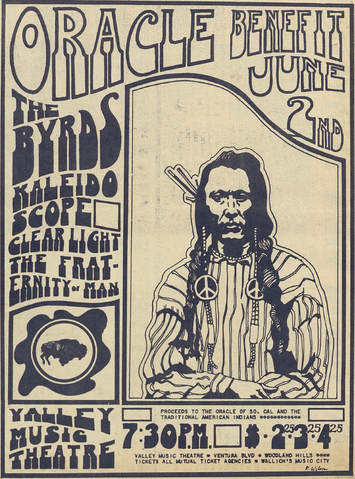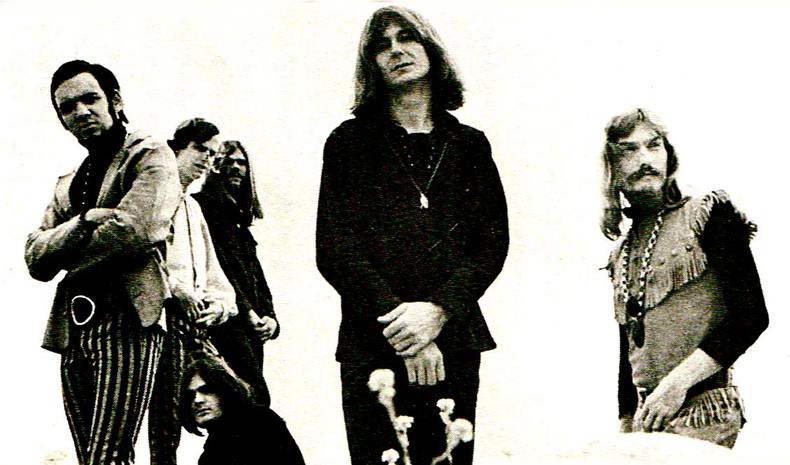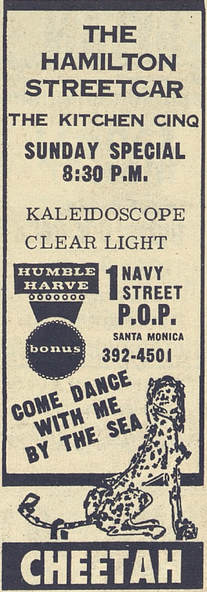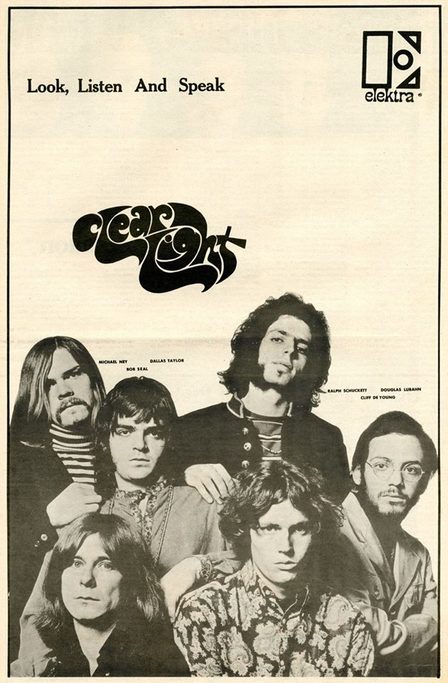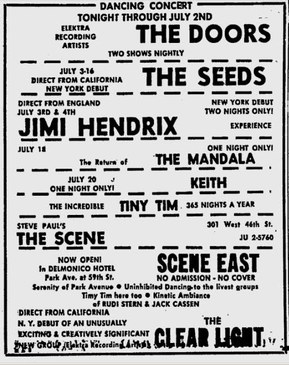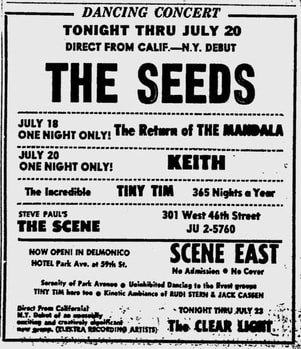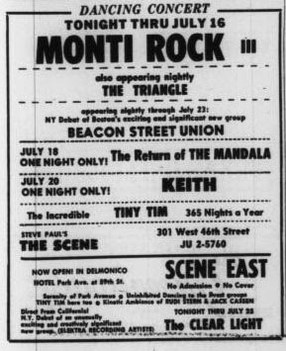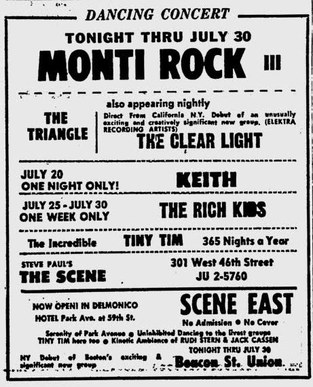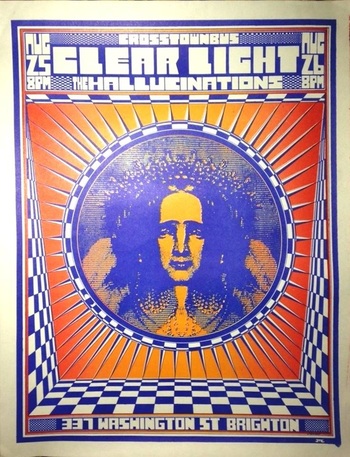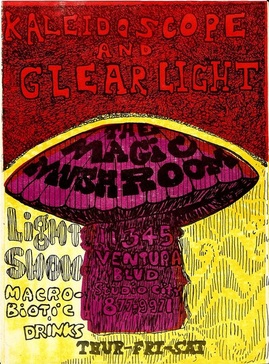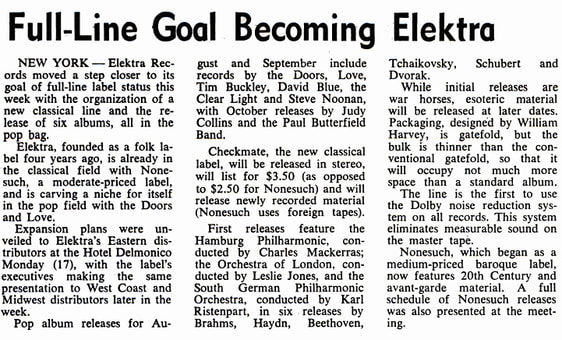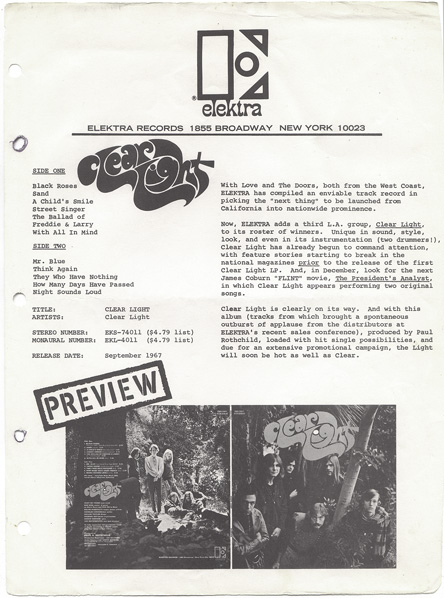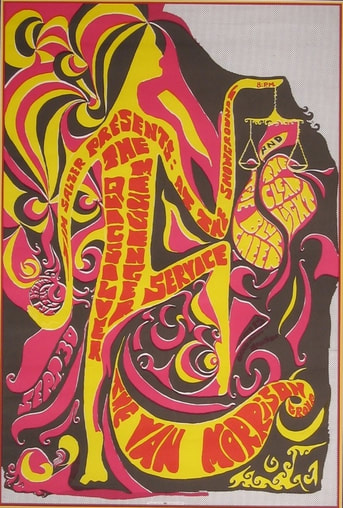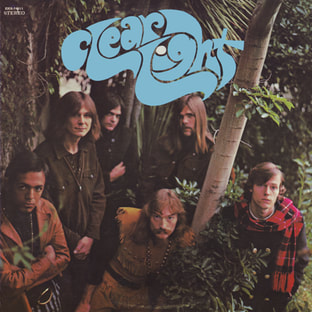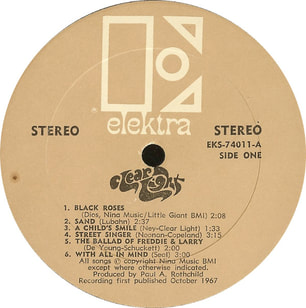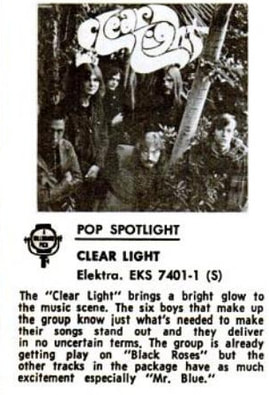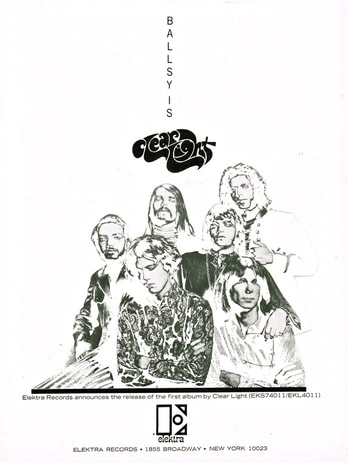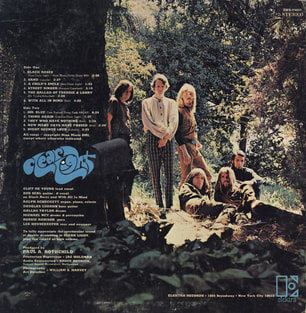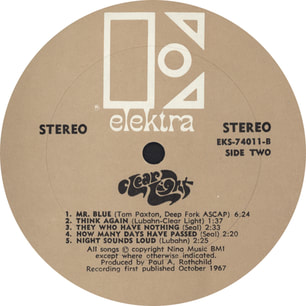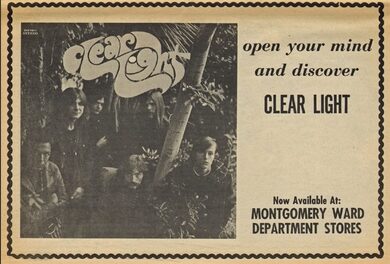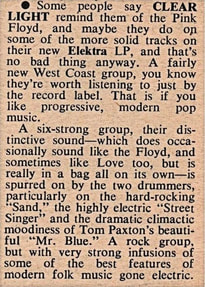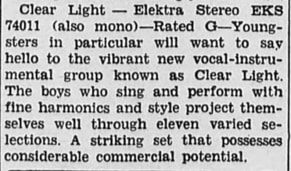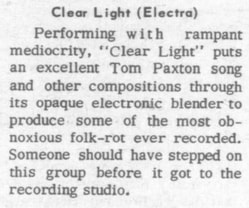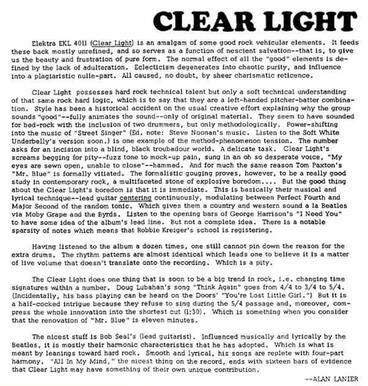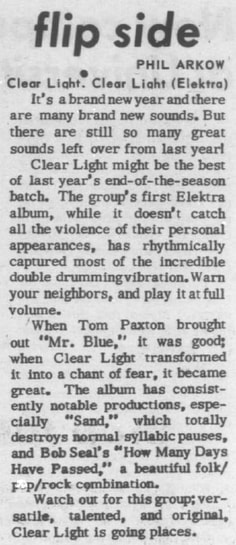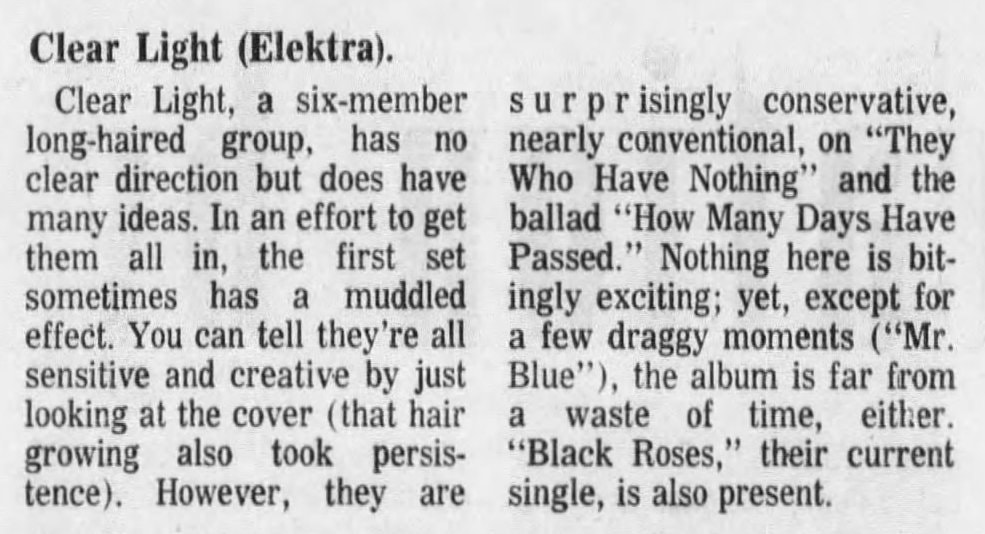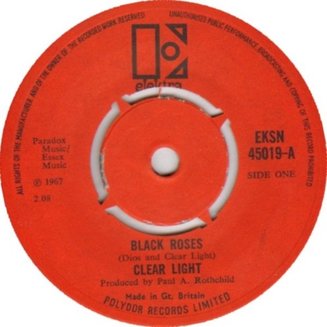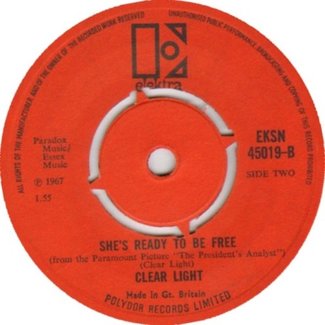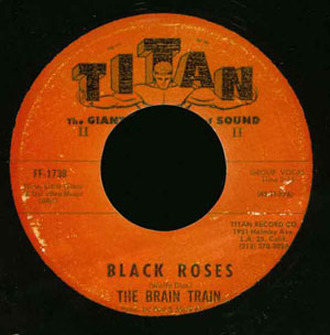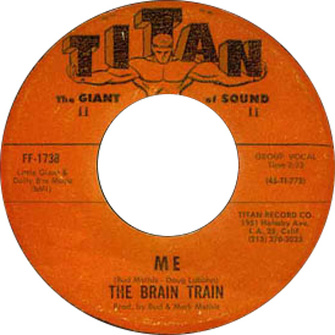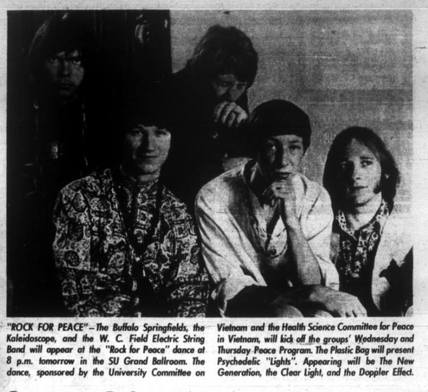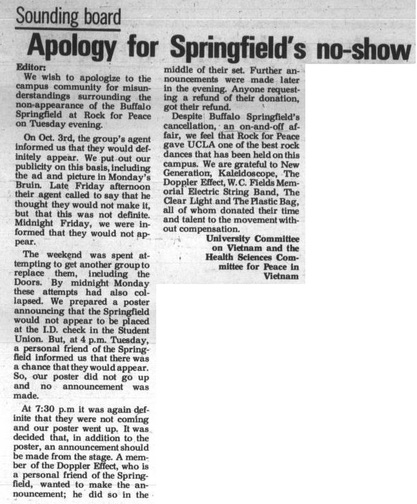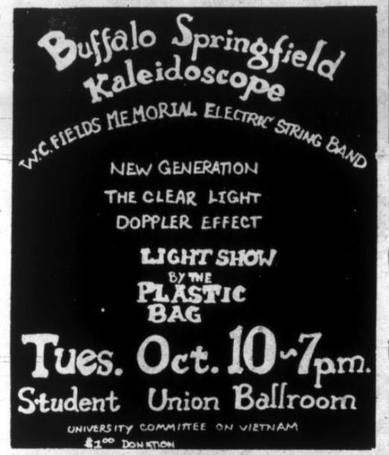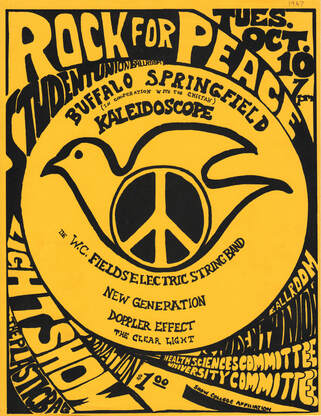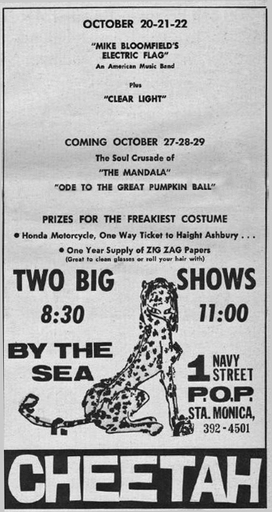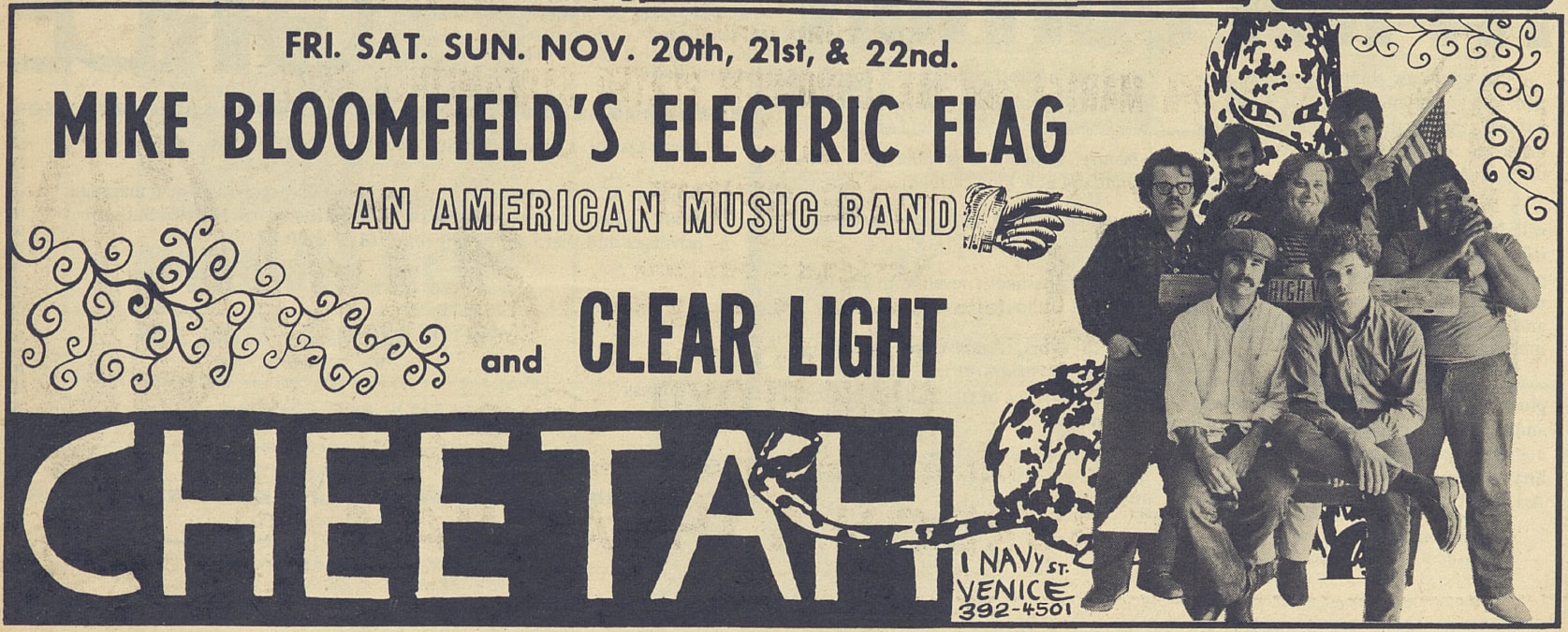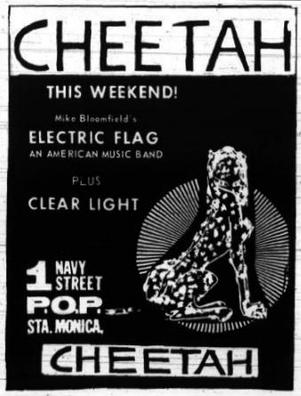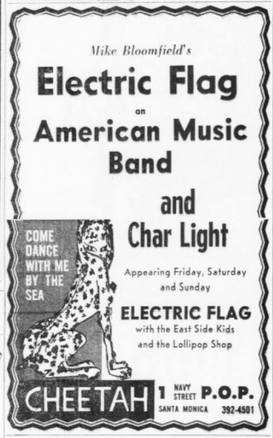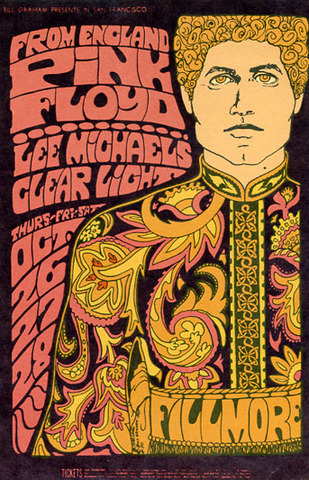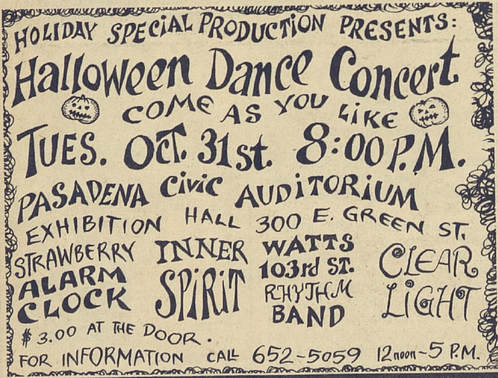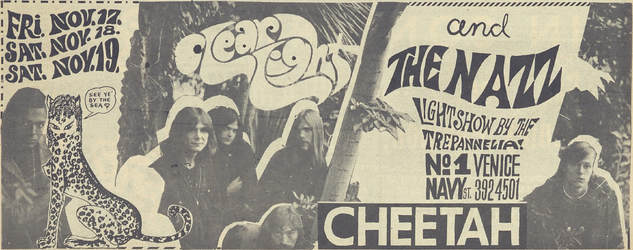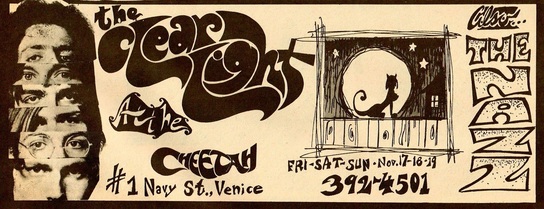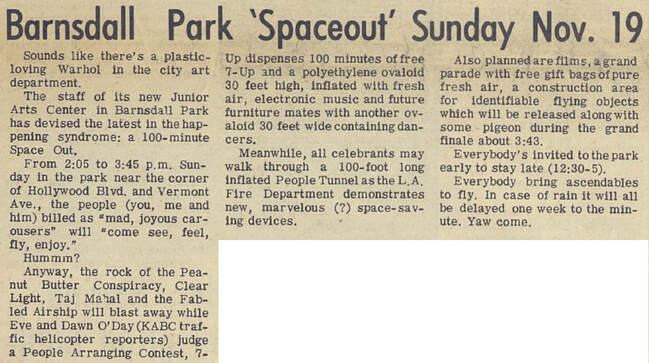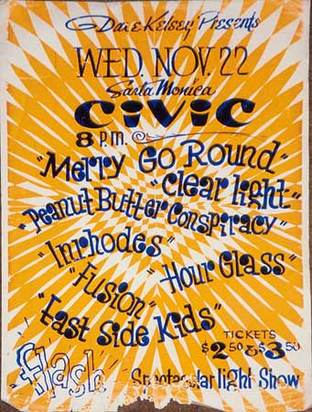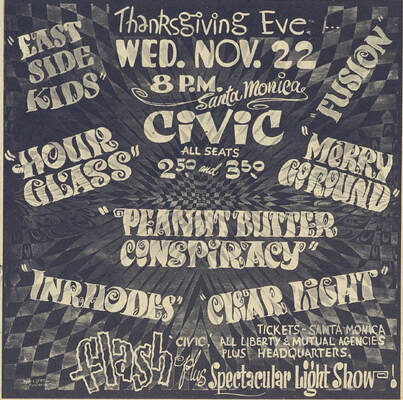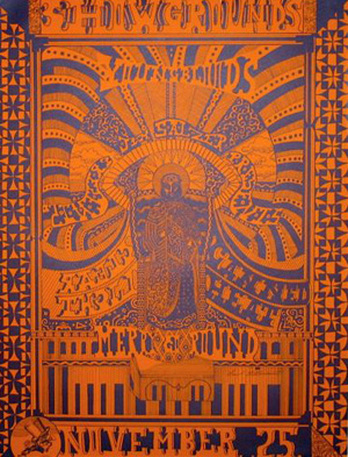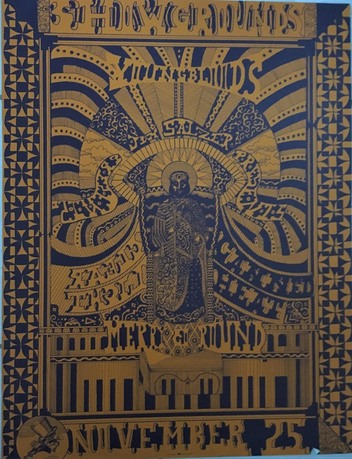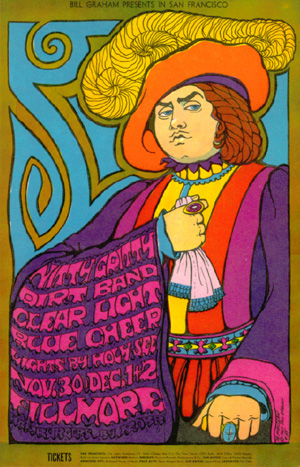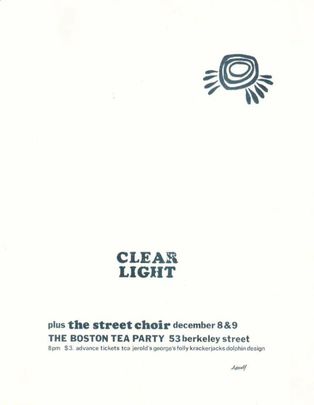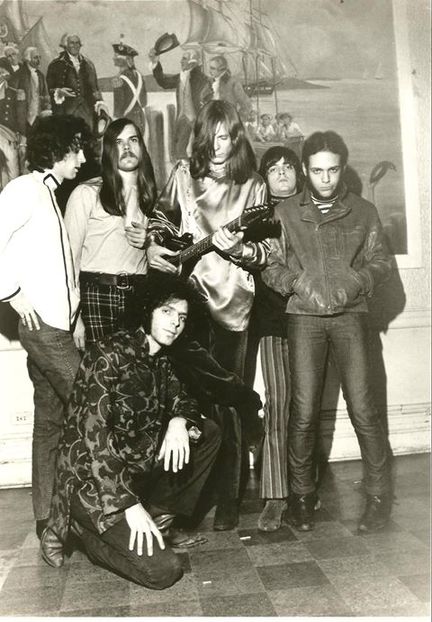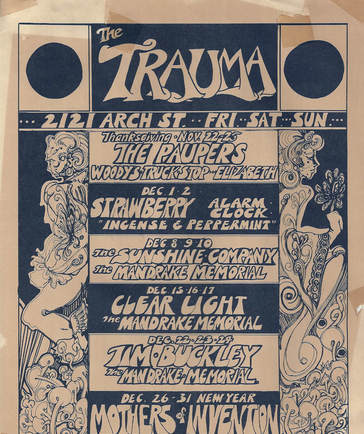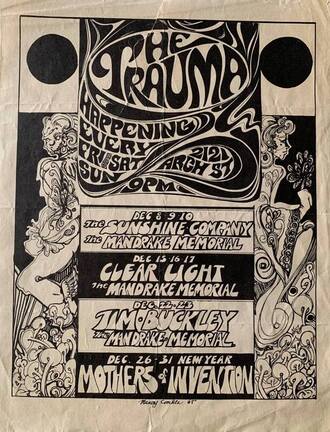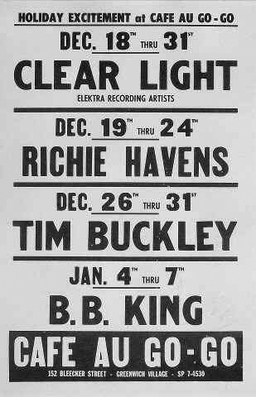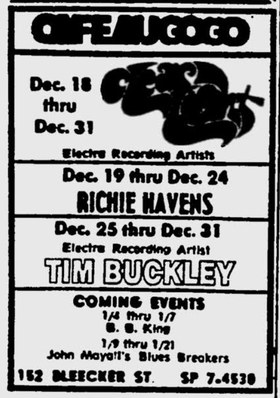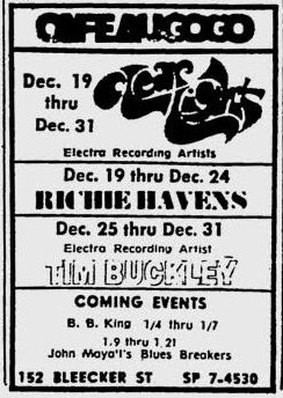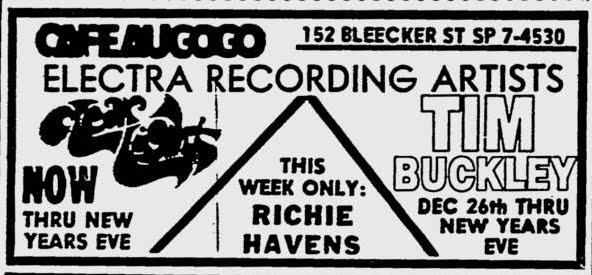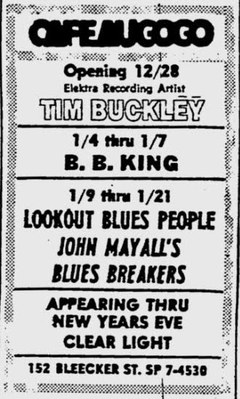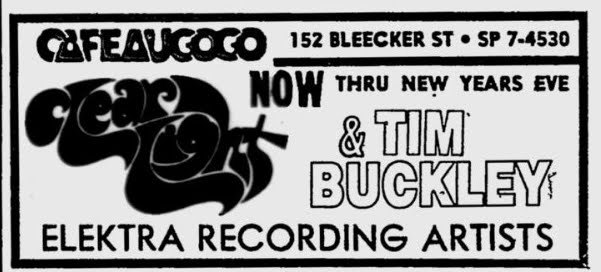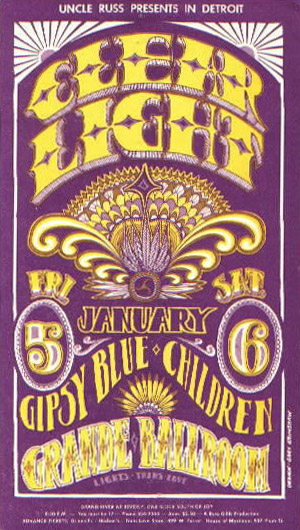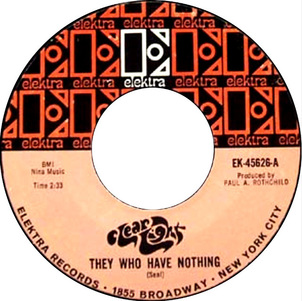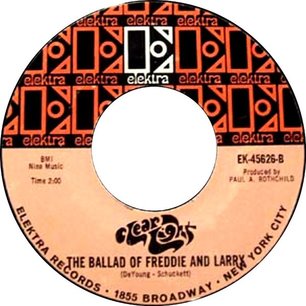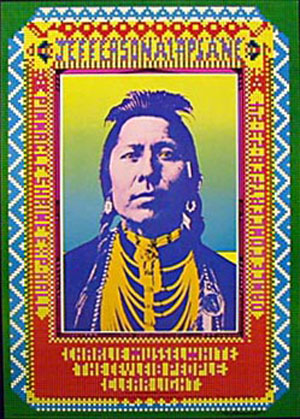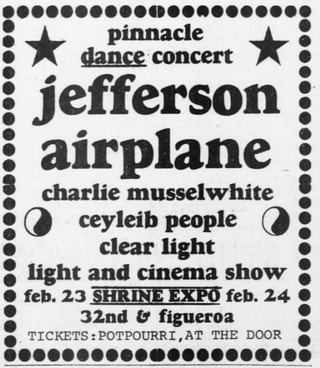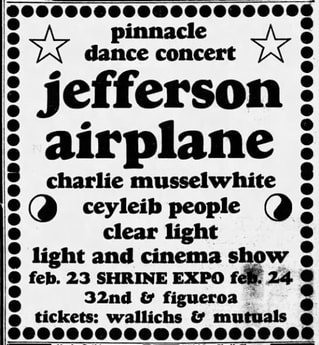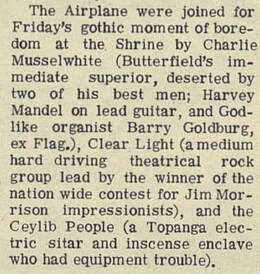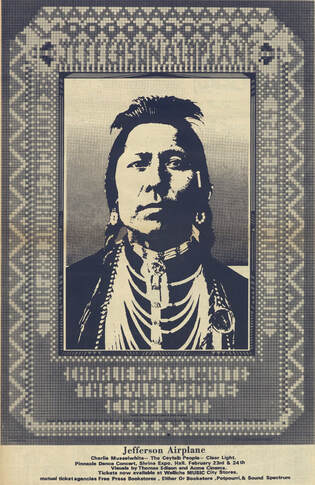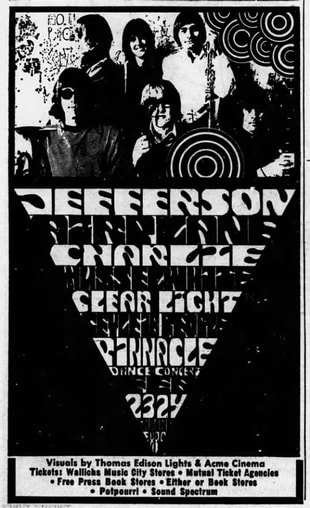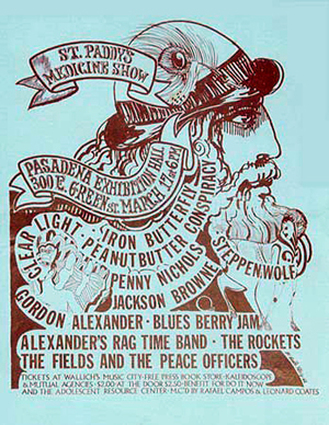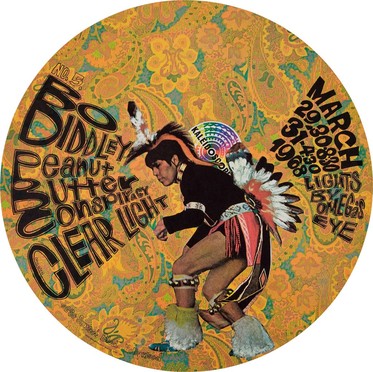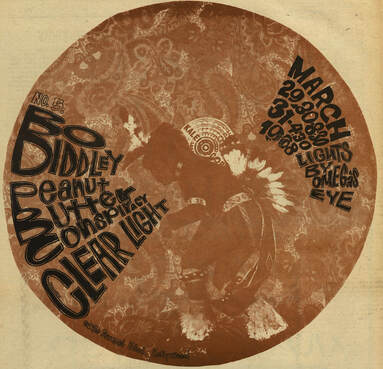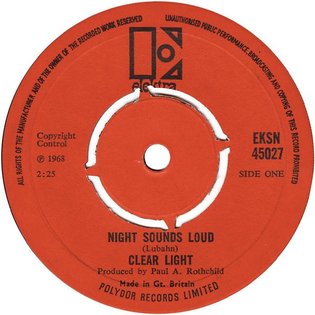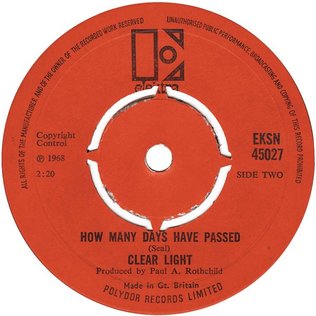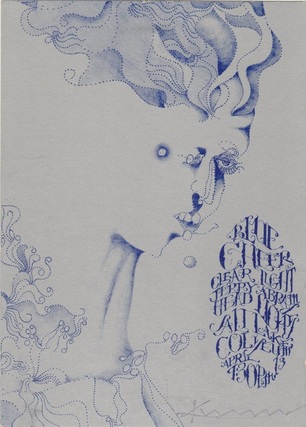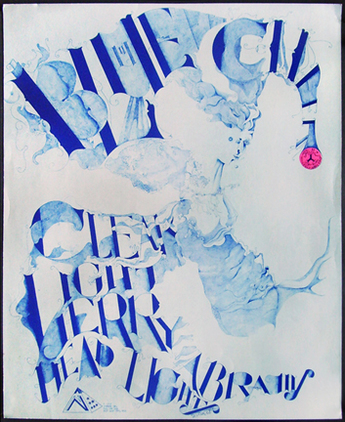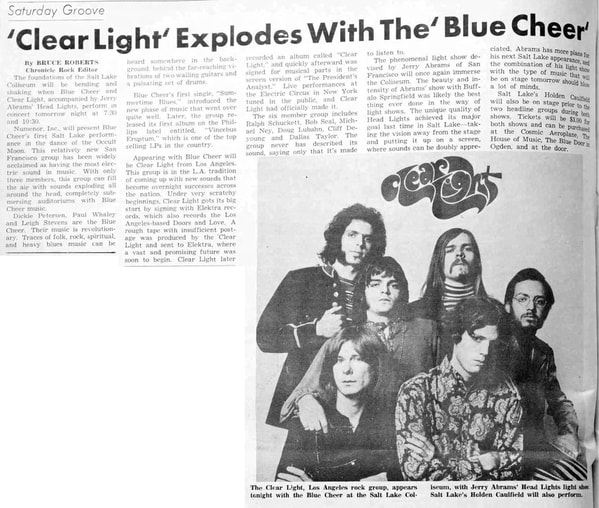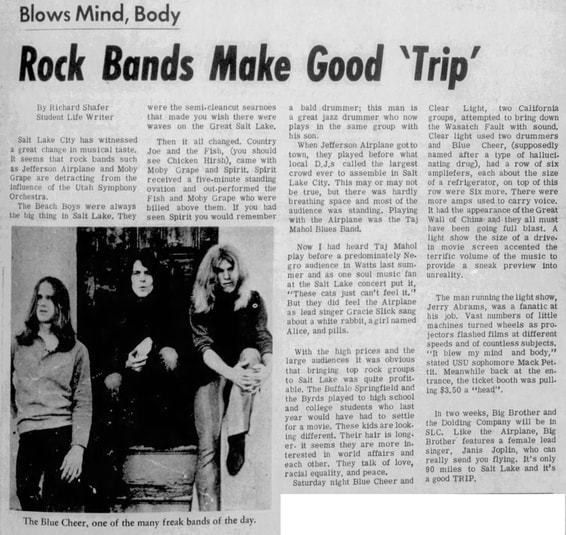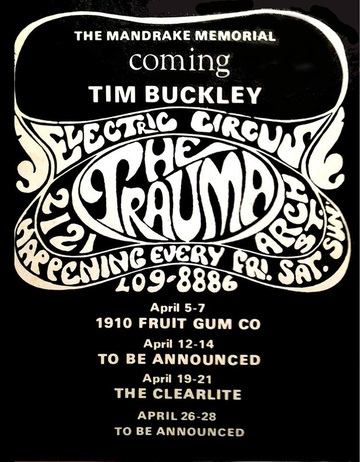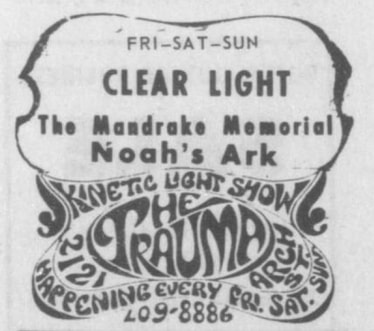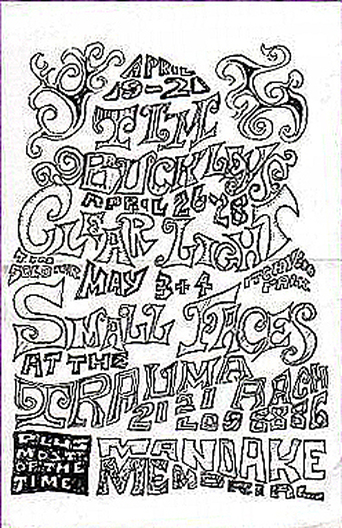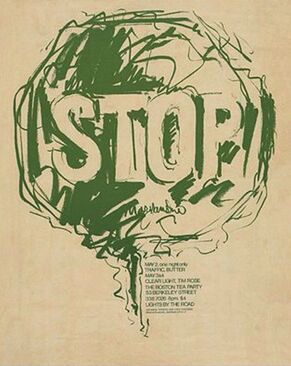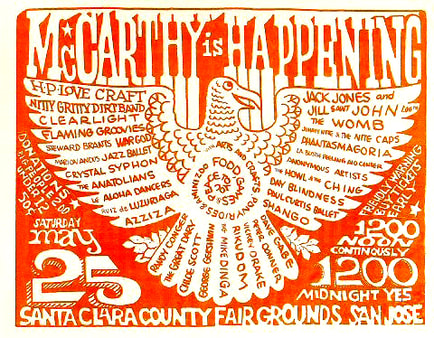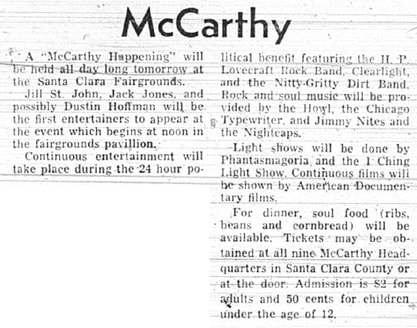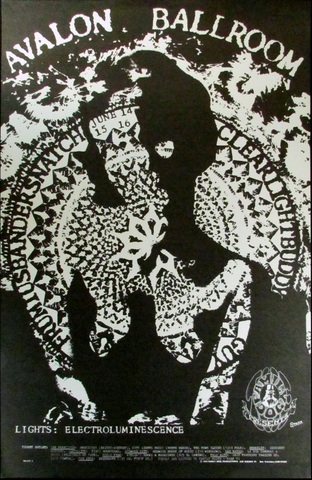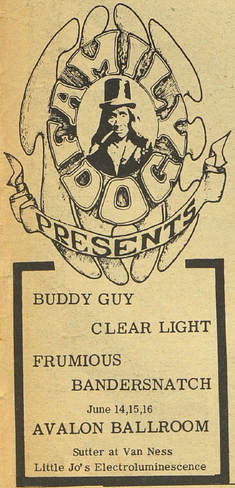If you enjoy what I have put together please consider donating any amount to support and help me to keep this valuable research going. Thanks!!
This day-by-day diary of Clear Light's live, studio, broadcasting and private activities is the result of three decades of research and interview work by Bruno Ceriotti, Gray Newell, and Nick Warburton, but without the significant contributions of other kindred spirits this diary would not have been possibile. So, we would like to thank all the people who, in one form or another, contributed to this timeline: Ross Hannan, Corry Arnold, Marc Skobac, Ralph Schuckett (RIP), Doug Lubahn (RIP), Alan Brackett, John Einarson, Bud Mathis, Wolfe Dios, Cliff DeYoung, Bob Seal, Paul D. Grushkin, Doug Hastings, Lee Houskeeper, Brian Hogg, Terry Hounsome, David Peter Housden, Vernon Joynson, Pete Long, Greg Shaw, Domenic Priore, Jerry Fuentes, Stu Rosenberg, Chaim O'Brien-Blumenthal, Deena Canale, Jeff Salisbury, Lillian Roxon, Eye Magazine, Richard Morton Jack, Steven M. Finger, Ed Murray, Dennis Donley, Andy Childs, ZigZag, Los Angeles Free Press, Jeff Schmidt, Jim Salzer, Luis Futre, Michael Fennelly, Michael Lazarus Scott, Walter Moore, The Daily Pennsylvanian, John H. Warburg, Los Angeles Times, Broadside, The Daily Californian, Independent Press Telegram, The Post Crescent Sun, The Daily Utah, Berkeley Barb, Student Life - Utah State University, Santa Cruz Sentinel.
March 1966 (?)
The story of Clear Light, one of the most underrated American psychedelic bands of the ‘60s, begins in Los Angeles, California, when guitarist Clyde Edgar ‘Robbie’ Robison (b. Thursday, January 27, 1938), a former folk singing lycanthrope under the name of ‘Robbie The Werewolf’ (one live album, At The Waleback, released in 1964) and drummer Michael Stephan Ney (b. Wednesday, May 29, 1946, Los Angeles), formerly of Tito Puente band, met by chance one day during an audition. “I had put a club band together, that was like a hard-line blues band,” Ney explains. “We were looking for another guitar player ‘cause I wanted to get rid of the keyboard player and go to three guitar combo, so we put the feelers out for a rhythm guitar player and Robbie showed up at the club one afternoon when we were in rehearsal and blew everybody’s mind. He was like a fish out of water; I mean he was like the absolute opposite of what we were looking for. I fell in love with the guy the minute he walked through the door—there was just something about him, he was so incredibly intense. He didn’t get the gig, but we became fast friends that afternoon.” Michael was living on his own in Inglewood at that time, but after the audition, Robbie invited him to come to Manhattan Beach where the latter lived with his pregnant wife Barbara in a rented one-bedroom cottage on 30th Street, close to the ocean. “I ended up going back to his house in Manhattan Beach and he and Barbara were there, they had this little bitty cottage down by the beach,” Michael recalls. “And he said, ‘You live alone in that house in Inglewood? Why the hell do you live there?’ I said well, it’s because everybody in my family is dead, I live alone. They wouldn’t have it, Barbara and Robbie both said, ‘No, you gotta give up that house, man, and you gotta move in with us,’ and for some reason, I did.” They soon hit on the idea of forming a group and began scouting around for musicians to join them. “We started looking for people to put a band together,” Michael continues. “We were going to Hollywood every night looking for players. We’d go to Bido Lito’s and all these Sunset Strip clubs as well, which was where all the real players were.”
April 1966 (?)
Robbie Robison and Michael Ney finally encountered some likely candidates for their soon-to-be band after a show of the Ashes, a folk-rock group fronted by Robbie’s singing wife Barbara, at the Waleback in Santa Monica, close to Venice Beach. It was the band’s bassist, Alan Brackett, who introduced them to a pair of musicians, Bob Seal and Dallas Taylor, he had just met that day who were also looking for like-minded musicians with whom to form a group. “I picked up Bob and Dallas hitching on Sunset and took them to my apartment in n Mar Vista. We then went to the Ashes gig at the Waleback in Venice, where they met Robbie and Barbara and Michael Ney,” Alan confirmed. The Georgia native singer and guitarist Robert Parker Seal, and his drummer pal Dallas Woodrow Taylor Jr. (b. Wednesday, April 7, 1948, Denver, Colorado), had just moved from Phoenix, Arizona, where they lived in the same house and where they getting high and listening to music. Inspired by the new sounds of the Byrds and the Mamas & Papas, they soon decided they should drive to Los Angeles and try and make the scene. Arriving in LA with very little money and no contacts, Bob and Dallas had no other option than to sleep in Taylor’s car while trying to find somewhere to live, so meeting up with Robbie and Michael proved to be a fortuitous turn of events. “Bob and I walked the streets looking for musicians,” Dallas recalled. “We had nowhere to stay. Robbie and Mike Ney had an apartment in Manhattan Beach, so... they were in the band! It just seemed like the right thing to do to have two drummers. I had noticed that Frank Zappa had two drummers and it sounded really great.” The two guitarist/two drummer lineup was unconventional, but they made it work, with Dallas and Michael playing off of each other, seamlessly blending fills and rolls between them, while Bob and Robbie traded guitar licks. “Dallas and I had it split up to where I'd start the fill and he'd finish it off,” Ney recalled, “or he'd start the fill and I'd finish the fill, y’know, the interchange, the stereo aspects of it were just unbelievable. I came from the thing of show bands playing with two drummers, most of the R&B bands had two drummers, and when I suggested it everyone went ‘What?’ I was like, ‘Dude, are you kidding? What about James Brown, Mitch Ryder & the Detroit Wheels?’ All these great show bands that had fucking great music, knockdown, drag-out, kick-ass music that no one could sit still to, they all had two drummers. And Dallas said, ‘Yeah I get it! OK, let’s do it!’”
The story of Clear Light, one of the most underrated American psychedelic bands of the ‘60s, begins in Los Angeles, California, when guitarist Clyde Edgar ‘Robbie’ Robison (b. Thursday, January 27, 1938), a former folk singing lycanthrope under the name of ‘Robbie The Werewolf’ (one live album, At The Waleback, released in 1964) and drummer Michael Stephan Ney (b. Wednesday, May 29, 1946, Los Angeles), formerly of Tito Puente band, met by chance one day during an audition. “I had put a club band together, that was like a hard-line blues band,” Ney explains. “We were looking for another guitar player ‘cause I wanted to get rid of the keyboard player and go to three guitar combo, so we put the feelers out for a rhythm guitar player and Robbie showed up at the club one afternoon when we were in rehearsal and blew everybody’s mind. He was like a fish out of water; I mean he was like the absolute opposite of what we were looking for. I fell in love with the guy the minute he walked through the door—there was just something about him, he was so incredibly intense. He didn’t get the gig, but we became fast friends that afternoon.” Michael was living on his own in Inglewood at that time, but after the audition, Robbie invited him to come to Manhattan Beach where the latter lived with his pregnant wife Barbara in a rented one-bedroom cottage on 30th Street, close to the ocean. “I ended up going back to his house in Manhattan Beach and he and Barbara were there, they had this little bitty cottage down by the beach,” Michael recalls. “And he said, ‘You live alone in that house in Inglewood? Why the hell do you live there?’ I said well, it’s because everybody in my family is dead, I live alone. They wouldn’t have it, Barbara and Robbie both said, ‘No, you gotta give up that house, man, and you gotta move in with us,’ and for some reason, I did.” They soon hit on the idea of forming a group and began scouting around for musicians to join them. “We started looking for people to put a band together,” Michael continues. “We were going to Hollywood every night looking for players. We’d go to Bido Lito’s and all these Sunset Strip clubs as well, which was where all the real players were.”
April 1966 (?)
Robbie Robison and Michael Ney finally encountered some likely candidates for their soon-to-be band after a show of the Ashes, a folk-rock group fronted by Robbie’s singing wife Barbara, at the Waleback in Santa Monica, close to Venice Beach. It was the band’s bassist, Alan Brackett, who introduced them to a pair of musicians, Bob Seal and Dallas Taylor, he had just met that day who were also looking for like-minded musicians with whom to form a group. “I picked up Bob and Dallas hitching on Sunset and took them to my apartment in n Mar Vista. We then went to the Ashes gig at the Waleback in Venice, where they met Robbie and Barbara and Michael Ney,” Alan confirmed. The Georgia native singer and guitarist Robert Parker Seal, and his drummer pal Dallas Woodrow Taylor Jr. (b. Wednesday, April 7, 1948, Denver, Colorado), had just moved from Phoenix, Arizona, where they lived in the same house and where they getting high and listening to music. Inspired by the new sounds of the Byrds and the Mamas & Papas, they soon decided they should drive to Los Angeles and try and make the scene. Arriving in LA with very little money and no contacts, Bob and Dallas had no other option than to sleep in Taylor’s car while trying to find somewhere to live, so meeting up with Robbie and Michael proved to be a fortuitous turn of events. “Bob and I walked the streets looking for musicians,” Dallas recalled. “We had nowhere to stay. Robbie and Mike Ney had an apartment in Manhattan Beach, so... they were in the band! It just seemed like the right thing to do to have two drummers. I had noticed that Frank Zappa had two drummers and it sounded really great.” The two guitarist/two drummer lineup was unconventional, but they made it work, with Dallas and Michael playing off of each other, seamlessly blending fills and rolls between them, while Bob and Robbie traded guitar licks. “Dallas and I had it split up to where I'd start the fill and he'd finish it off,” Ney recalled, “or he'd start the fill and I'd finish the fill, y’know, the interchange, the stereo aspects of it were just unbelievable. I came from the thing of show bands playing with two drummers, most of the R&B bands had two drummers, and when I suggested it everyone went ‘What?’ I was like, ‘Dude, are you kidding? What about James Brown, Mitch Ryder & the Detroit Wheels?’ All these great show bands that had fucking great music, knockdown, drag-out, kick-ass music that no one could sit still to, they all had two drummers. And Dallas said, ‘Yeah I get it! OK, let’s do it!’”
UNNAMED REHEARSAL BAND (APRIL 1966 (?) - OCTOBER 1966)
1) Bob Seal vocals, lead guitar
2) Dallas Taylor drums
3) Michael Ney drums, percussion
4) Robbie Robison acoustic guitar
1) Bob Seal vocals, lead guitar
2) Dallas Taylor drums
3) Michael Ney drums, percussion
4) Robbie Robison acoustic guitar
September 1966
While “messing around” with Michael, Robbie and Bob in Manhattan Beach, Dallad Taylor also auditioned for an up-and-coming Hollywood-based rock band called The Factory, which was fronted by the not-yet famous singer and guitarist Lowell George. He passed the audition and joined the band, but came down with appendicitis and had to undergo surgery just before his debut gig with them for a “freak out” show at the Shrine Exposition Hall on September 17, headlined by the Mothers of Invention. Despite being in recovery from his operation, Dallas opted to play the show anyway, but neglected to tell the rest of the band about his recent medical issues. In an interview with Andy Childs for ZigZag magazine in 1975, Lowell George recalled how the night unfolded: “We had Dallas Taylor playing drums in the band at the time, and he had just come from Texas or somewhere and had had an appendix operation. I didn’t know anything about it, but he was ripping his stitches while he was playing the drums. He was dropping the beats and slowing down, and I thought, ‘Wow, this guy’s terrible. I’ve got to get another drummer.’ He was actually very good, but he was ill. And I didn’t find out until years later that he was bleeding through his shirt. I mean he needed the money real bad and was so honorable that he wouldn’t cop to the fact that he was sick.” As a result, Dallas was dropped from the Factory and Richie Hayward came in to replace him. After the show Dallas had to go back to the hospital to get himself fixed up, but was unfazed by the experience: “I was bleeding through my bandage. It was really cool.”
October 1966
The unnamed rehearsal band added a female singer named Wanda Watkins, a friend of Robbie and Barbara who used to babysit their son Scott, which was born only a month earlier on September 3. Bob Seal was an accomplished vocalist, but, with an ear to enhance their vocal range, Wanda came in as an additional singer after the group had been unsuccessful in trying to persuade Barbara to join them. The latter, in fact, had just rejoined with her former Ashes bandmates, John Merrill and Alan Brackett, to form a new band called the Peanut Butter Conspiracy (and the rest is history). Anyway, at that point Wanda moved into the Manhattan Beach cottage with the rest of the guys (she eventually became Robbie’s girlfriend after he split up with Barbara shortly after), and the quintet finally named themselves as the Garnerfield Sanitarium, a name that presented itself one day as Dallas and the band were out driving. “Garnerfield Sanitarium is a real place,” he explained, “we were all riding around stoned in my Mustang and saw the sign. We all said ‘what a great name.’”
While “messing around” with Michael, Robbie and Bob in Manhattan Beach, Dallad Taylor also auditioned for an up-and-coming Hollywood-based rock band called The Factory, which was fronted by the not-yet famous singer and guitarist Lowell George. He passed the audition and joined the band, but came down with appendicitis and had to undergo surgery just before his debut gig with them for a “freak out” show at the Shrine Exposition Hall on September 17, headlined by the Mothers of Invention. Despite being in recovery from his operation, Dallas opted to play the show anyway, but neglected to tell the rest of the band about his recent medical issues. In an interview with Andy Childs for ZigZag magazine in 1975, Lowell George recalled how the night unfolded: “We had Dallas Taylor playing drums in the band at the time, and he had just come from Texas or somewhere and had had an appendix operation. I didn’t know anything about it, but he was ripping his stitches while he was playing the drums. He was dropping the beats and slowing down, and I thought, ‘Wow, this guy’s terrible. I’ve got to get another drummer.’ He was actually very good, but he was ill. And I didn’t find out until years later that he was bleeding through his shirt. I mean he needed the money real bad and was so honorable that he wouldn’t cop to the fact that he was sick.” As a result, Dallas was dropped from the Factory and Richie Hayward came in to replace him. After the show Dallas had to go back to the hospital to get himself fixed up, but was unfazed by the experience: “I was bleeding through my bandage. It was really cool.”
October 1966
The unnamed rehearsal band added a female singer named Wanda Watkins, a friend of Robbie and Barbara who used to babysit their son Scott, which was born only a month earlier on September 3. Bob Seal was an accomplished vocalist, but, with an ear to enhance their vocal range, Wanda came in as an additional singer after the group had been unsuccessful in trying to persuade Barbara to join them. The latter, in fact, had just rejoined with her former Ashes bandmates, John Merrill and Alan Brackett, to form a new band called the Peanut Butter Conspiracy (and the rest is history). Anyway, at that point Wanda moved into the Manhattan Beach cottage with the rest of the guys (she eventually became Robbie’s girlfriend after he split up with Barbara shortly after), and the quintet finally named themselves as the Garnerfield Sanitarium, a name that presented itself one day as Dallas and the band were out driving. “Garnerfield Sanitarium is a real place,” he explained, “we were all riding around stoned in my Mustang and saw the sign. We all said ‘what a great name.’”
THE GARNERFIELD SANITARIUM #1 (OCTOBER 1966 - NOVEMBER 1966)
1) Bob Seal
2) Dallas Taylor
3) Michael Ney
4) Robbie Robison
5) Wanda Watkins vocals, tambourine
1) Bob Seal
2) Dallas Taylor
3) Michael Ney
4) Robbie Robison
5) Wanda Watkins vocals, tambourine
November 1966
After a few warm-up gigs in bars around the Manhattan Beach area, the band concluded that a bass player was required to complete the lineup, and soon they hired one named Douglas H. ‘Doug’ Lubahn (b. Friday, December 19, 1947, Golden, Colorado). Mostly known today as “The 5th Doors” after he played as sessionman in the Doors’ albums Strange Days, Waiting For The Sun, and The Soft Parade, between 1967 and 1969, Lubahn had spent six years studying French horn before switching to bass guitar during his freshman year after the most popular band at his high school, the Carpetbaggers, asked him to join. After leaving school in 1965, he hitchhiked to Aspen where, at the tender age of seventeen, became the youngest ski instructor ever to be employed there. Après-ski he would often sit in with bands that played the clubs and bars around the resort. In January 1966 an outfit from LA named the Candy Store came along and Doug was soon joining in with their nightly sets. Among the Candy Store’s entourage was the great late singer ‘Mama Cass’ Elliot. Impressed with Doug’s prowess on the bass, Cass persuaded him to accompany her back to LA where good bassists were in short supply. After a couple of weeks of hanging out with Cass, Doug was anxious not to outstay his welcome and so decided to find his own way. For a while, the owner of a club called the Sea Witch took pity on him and let him sleep on the back deck, which was set up like a fake beach with sand and an old boat, but he eventually managed to find a place to rent at 1234 North Formosa Avenue in West Hollywood, a move that was to prove to be a turning point in his life. “I was living on the street on Sunset Strip, sleeping in the bushes,” Doug recalled. “Another street waif like myself offered to share a basement in an apartment building on Fountain [sic] Avenue. Said that the ‘building manager’ was a cool guy and wouldn’t mind. That cool guy was Bud Mathis. Bud took a little getting used to, a gruff exterior hiding one of the biggest hearts in the world. After listening to me on his porch for so many days and nights playing bass lines on his acoustic guitar, he actually went and bought me a bass and amplifier. His words when he gave them to me were simple: ‘This is a gift to you from me. You should be playing bass.’ The memory of that moment: him standing near his couch...with the bass leaning up against it...is a precious picture that will never fade. I can still feel the happiness in his eyes. Sometimes it is hard to put things into words: this is one of those moments for me.” Now Doug had a bass guitar there was nothing to stop him from looking for a band to join. He had heard that Canter’s Deli at 417-19 North Fairfax Avenue was the place to be for musicians looking for a gig, so he headed up there one night to see what he might find. Among the crowds of people milling around the sidewalk outside the deli, he saw a pair of guys with signs pinned to their shirts that read “We need a bass player” so he went over and introduced himself, which is how he first met Bob Seal and Dallas Taylor. They told him about the Garnerfield Sanitarium and their pad on Manhattan Beach and invited Doug to come and check it out. He didn’t need to be asked twice and pretty soon he was zooming along the highway in Taylor’s Mustang on his way to the Robison’s cottage, stopping off en-route to pick up his bass and other belongings from the apartment building. By the way, another resident of the North Formosa Avenue apartment building was a young Swiss songwriter and musician named Wolfgang ‘Wolfe’ Dios who had become good friends with Doug. Before long he was hanging out with the Garnerfield Sanitarium in Manhattan Beach where he would join in with the band playing rhythm guitar while they were rehearsing. “I played rhythm guitar for [them] briefly,” he recalled, “only for a month or so, I wasn’t that great a guitarist, but they were desperate and the band was quite new.”
After a few warm-up gigs in bars around the Manhattan Beach area, the band concluded that a bass player was required to complete the lineup, and soon they hired one named Douglas H. ‘Doug’ Lubahn (b. Friday, December 19, 1947, Golden, Colorado). Mostly known today as “The 5th Doors” after he played as sessionman in the Doors’ albums Strange Days, Waiting For The Sun, and The Soft Parade, between 1967 and 1969, Lubahn had spent six years studying French horn before switching to bass guitar during his freshman year after the most popular band at his high school, the Carpetbaggers, asked him to join. After leaving school in 1965, he hitchhiked to Aspen where, at the tender age of seventeen, became the youngest ski instructor ever to be employed there. Après-ski he would often sit in with bands that played the clubs and bars around the resort. In January 1966 an outfit from LA named the Candy Store came along and Doug was soon joining in with their nightly sets. Among the Candy Store’s entourage was the great late singer ‘Mama Cass’ Elliot. Impressed with Doug’s prowess on the bass, Cass persuaded him to accompany her back to LA where good bassists were in short supply. After a couple of weeks of hanging out with Cass, Doug was anxious not to outstay his welcome and so decided to find his own way. For a while, the owner of a club called the Sea Witch took pity on him and let him sleep on the back deck, which was set up like a fake beach with sand and an old boat, but he eventually managed to find a place to rent at 1234 North Formosa Avenue in West Hollywood, a move that was to prove to be a turning point in his life. “I was living on the street on Sunset Strip, sleeping in the bushes,” Doug recalled. “Another street waif like myself offered to share a basement in an apartment building on Fountain [sic] Avenue. Said that the ‘building manager’ was a cool guy and wouldn’t mind. That cool guy was Bud Mathis. Bud took a little getting used to, a gruff exterior hiding one of the biggest hearts in the world. After listening to me on his porch for so many days and nights playing bass lines on his acoustic guitar, he actually went and bought me a bass and amplifier. His words when he gave them to me were simple: ‘This is a gift to you from me. You should be playing bass.’ The memory of that moment: him standing near his couch...with the bass leaning up against it...is a precious picture that will never fade. I can still feel the happiness in his eyes. Sometimes it is hard to put things into words: this is one of those moments for me.” Now Doug had a bass guitar there was nothing to stop him from looking for a band to join. He had heard that Canter’s Deli at 417-19 North Fairfax Avenue was the place to be for musicians looking for a gig, so he headed up there one night to see what he might find. Among the crowds of people milling around the sidewalk outside the deli, he saw a pair of guys with signs pinned to their shirts that read “We need a bass player” so he went over and introduced himself, which is how he first met Bob Seal and Dallas Taylor. They told him about the Garnerfield Sanitarium and their pad on Manhattan Beach and invited Doug to come and check it out. He didn’t need to be asked twice and pretty soon he was zooming along the highway in Taylor’s Mustang on his way to the Robison’s cottage, stopping off en-route to pick up his bass and other belongings from the apartment building. By the way, another resident of the North Formosa Avenue apartment building was a young Swiss songwriter and musician named Wolfgang ‘Wolfe’ Dios who had become good friends with Doug. Before long he was hanging out with the Garnerfield Sanitarium in Manhattan Beach where he would join in with the band playing rhythm guitar while they were rehearsing. “I played rhythm guitar for [them] briefly,” he recalled, “only for a month or so, I wasn’t that great a guitarist, but they were desperate and the band was quite new.”
THE GARNERFIELD SANITARIUM #2 (NOVEMBER 1966)
1) Bob Seal
2) Dallas Taylor
3) Michael Ney
4) Robbie Robison
5) Wanda Watkins
6) Doug Lubahn bass
7) Wolfgang ‘Wolfe’ Dios rhythm guitar
1) Bob Seal
2) Dallas Taylor
3) Michael Ney
4) Robbie Robison
5) Wanda Watkins
6) Doug Lubahn bass
7) Wolfgang ‘Wolfe’ Dios rhythm guitar
November 1966
The fledgling band hired the abovementioned Doug Lubahn’s friend Bud Mathis as their manager. Forrest Rew ‘Bud’ Mathis was a fascinating character who had been a professional boxer, trading blows as ‘Babyface Mathis’ in the late 1940s, and was the Arizona Lightweight Champion from 1951 to 1954. Disillusioned with boxing, Bud had relocated to Los Angeles in the early sixties where he made the transition into the music business as a songwriter. One of his first recorded compositions was a Beatles cash in, ‘Yes, You Can Hold My Hand,’ credited to the Teen Bugs and released in 1964. Having enjoyed a modicum of success as a writer he set up his own publishing company, which he called Little Giant Music. One night Wolfe Dios brought Bud out to see the group rehearse. In his autobiography Confessions of a Robot, Bud provides an interesting description of his first encounter with the Garnerfield Sanitarium. “Wolfie and I drove down to a beach town, south of Hollywood where the band lived, to meet them. And have them audition for me. The understanding was that if I liked them I would take them into a studio and record them on a couple of songs. Then, I would attempt to get the group signed to a label. What I saw were some guys with the totaled-out Sixties look, plus a young female with the same look. ‘Hippies’ was the term generally applied to young people who looked like them. They wore the look like a badge of honor. The prerequisite identifying factors being, long hair on the guys, and no lipstick, or other makeup on the girls, and of course, no bra. Also, colorful clothes on both. No torn jeans on the sixties hippies. They liked flash. They played a few songs for me and I was impressed. Not that I thought I knew anything about the competence of musicians. Or singers. I didn’t. Nor did it matter. All I cared about was did I like what I heard? I figured I represented the non-musician public. I liked what I heard that night.” As a result of Bud’s enthusiasm for the Garnerfield Sanitarium, the group asked him to become their manager. “When the band learned I was willing to spend some money on them they came up with the idea I should represent them. Like maybe become their manager. I really wasn’t too sure that was a good idea. I didn’t know anything about managing a band. Not to worry. They would teach me everything I needed to know. They weren’t kidding. They started right in giving me the scoop on what to ask for from a label. Suffice it to say I succumbed to their persistence and agreed to take on the task of steering their career. On a handshake. Contracts could come later.”
November 1966: Electro-Vox Recording Studios, 5546 Melrose Avenue, Hollywood, Los Angeles County, California
The Garnerfield Sanitarium recorded a demo of two original songs: ‘Black Roses’, written by Wolfe Dios during a break of the band’s reharsals at the Manhattan Beach house, and ‘Me,’ a quasi-mystical number written by Bud Mathis and Doug Lubahn while the latter had still been living on North Formosa Avenue. Bud financed the session and also co-produced it with his son Mark under the guidance of producer John Marascalco, who had made a name for himself as a songwriter after penning ‘Good Golly Miss Molly’ and ‘Rip It Up,’ which would become massive hits when recorded by Little Richard. It was a steep learning curve for Mathis but, thanks to the preparation the group had put in before the session, everything went smoothly. “The recording session was a great experience for me,” he wrote in his autobiography. “I already knew, from all the demos I had done of my songs how easy it was to waste a lot of time and money if the group wasn’t rehearsed and ready. Fortunately, this group had come prepared. They were great. Bob Seal was right on the money with his passionate rendition of both songs. He tore the walls down on the guitar solo. He was sealing the deal with his signature vocals. Nobody could have done it better. I remember thinking a record deal was in the bag. Dallas Taylor was the touch of perfection in keeping the beat and powerful drum accents and fills. Michael Ney, the other drummer was right alongside him, adding to the power. Everybody else was fired to their peak performance by these three and they all did great. Both songs came out with the sound and feel of the times. I was real pleased.” Anyway, during the recording process the Garnerfield Sanitarium underwent a couple of changes, taking on a new identity as the Brain Train, a name conjured up for them by Alan Brackett (and maybe inspired by a big fat joint), while losing Wanda Watkins from the lineup to become a six-piece. According to Wolfe Dios, there had been some conflict between Watkins and Bob Seal over who should sing the lead vocal: “Bob got into a furious argument with Wanda. She got fed up and literally stalked out of the studio.” Wanda, who in the end sang backup vocals on ‘Black Roses,’ some months later joined the Joint Effort, another local group that Mathis would go on to manage.
The fledgling band hired the abovementioned Doug Lubahn’s friend Bud Mathis as their manager. Forrest Rew ‘Bud’ Mathis was a fascinating character who had been a professional boxer, trading blows as ‘Babyface Mathis’ in the late 1940s, and was the Arizona Lightweight Champion from 1951 to 1954. Disillusioned with boxing, Bud had relocated to Los Angeles in the early sixties where he made the transition into the music business as a songwriter. One of his first recorded compositions was a Beatles cash in, ‘Yes, You Can Hold My Hand,’ credited to the Teen Bugs and released in 1964. Having enjoyed a modicum of success as a writer he set up his own publishing company, which he called Little Giant Music. One night Wolfe Dios brought Bud out to see the group rehearse. In his autobiography Confessions of a Robot, Bud provides an interesting description of his first encounter with the Garnerfield Sanitarium. “Wolfie and I drove down to a beach town, south of Hollywood where the band lived, to meet them. And have them audition for me. The understanding was that if I liked them I would take them into a studio and record them on a couple of songs. Then, I would attempt to get the group signed to a label. What I saw were some guys with the totaled-out Sixties look, plus a young female with the same look. ‘Hippies’ was the term generally applied to young people who looked like them. They wore the look like a badge of honor. The prerequisite identifying factors being, long hair on the guys, and no lipstick, or other makeup on the girls, and of course, no bra. Also, colorful clothes on both. No torn jeans on the sixties hippies. They liked flash. They played a few songs for me and I was impressed. Not that I thought I knew anything about the competence of musicians. Or singers. I didn’t. Nor did it matter. All I cared about was did I like what I heard? I figured I represented the non-musician public. I liked what I heard that night.” As a result of Bud’s enthusiasm for the Garnerfield Sanitarium, the group asked him to become their manager. “When the band learned I was willing to spend some money on them they came up with the idea I should represent them. Like maybe become their manager. I really wasn’t too sure that was a good idea. I didn’t know anything about managing a band. Not to worry. They would teach me everything I needed to know. They weren’t kidding. They started right in giving me the scoop on what to ask for from a label. Suffice it to say I succumbed to their persistence and agreed to take on the task of steering their career. On a handshake. Contracts could come later.”
November 1966: Electro-Vox Recording Studios, 5546 Melrose Avenue, Hollywood, Los Angeles County, California
The Garnerfield Sanitarium recorded a demo of two original songs: ‘Black Roses’, written by Wolfe Dios during a break of the band’s reharsals at the Manhattan Beach house, and ‘Me,’ a quasi-mystical number written by Bud Mathis and Doug Lubahn while the latter had still been living on North Formosa Avenue. Bud financed the session and also co-produced it with his son Mark under the guidance of producer John Marascalco, who had made a name for himself as a songwriter after penning ‘Good Golly Miss Molly’ and ‘Rip It Up,’ which would become massive hits when recorded by Little Richard. It was a steep learning curve for Mathis but, thanks to the preparation the group had put in before the session, everything went smoothly. “The recording session was a great experience for me,” he wrote in his autobiography. “I already knew, from all the demos I had done of my songs how easy it was to waste a lot of time and money if the group wasn’t rehearsed and ready. Fortunately, this group had come prepared. They were great. Bob Seal was right on the money with his passionate rendition of both songs. He tore the walls down on the guitar solo. He was sealing the deal with his signature vocals. Nobody could have done it better. I remember thinking a record deal was in the bag. Dallas Taylor was the touch of perfection in keeping the beat and powerful drum accents and fills. Michael Ney, the other drummer was right alongside him, adding to the power. Everybody else was fired to their peak performance by these three and they all did great. Both songs came out with the sound and feel of the times. I was real pleased.” Anyway, during the recording process the Garnerfield Sanitarium underwent a couple of changes, taking on a new identity as the Brain Train, a name conjured up for them by Alan Brackett (and maybe inspired by a big fat joint), while losing Wanda Watkins from the lineup to become a six-piece. According to Wolfe Dios, there had been some conflict between Watkins and Bob Seal over who should sing the lead vocal: “Bob got into a furious argument with Wanda. She got fed up and literally stalked out of the studio.” Wanda, who in the end sang backup vocals on ‘Black Roses,’ some months later joined the Joint Effort, another local group that Mathis would go on to manage.
THE BRAIN TRAIN #1 (NOVEMBER 1966 - DECEMBER 1966)
1) Bob Seal
2) Dallas Taylor
3) Michael Ney
4) Robbie Robison
5) Doug Lubahn
6) Wolfgang ‘Wolfe’ Dios
1) Bob Seal
2) Dallas Taylor
3) Michael Ney
4) Robbie Robison
5) Doug Lubahn
6) Wolfgang ‘Wolfe’ Dios
November - December 1966
Bud Mathis started the process of hawking the 2-song demo around to try and secure a deal with a record label. “I loved what I walked out of the studio with,” he recalled. “I was convinced the band had done a great job and I was right. So, I got on the phone and made a few calls and ran into defensive receptionists who took messages for A&R guys, who never called back. I’d been through this many times before. So I decided to try my luck at cold calling, in person. So, I went over to Sunset and Vine and went into the tall skinny building on the southeast corner. I didn’t know if there was a record company in there or not, but I figured there might be. I was right. There on the directory was Elektra Records. Bullseye. Into the elevator, and up I went.” As luck would have it, the first person Bud encountered was Billy James, now working as Elektra’s West Coast A&R man. Bud played him the Brain Train acetate and Billy liked what he heard enough to refer the group to Jac Holzman, Elektra’s head honcho, in New York City. In due time word came back and the Brain Train was offered a contract that met the terms they had asked Bud to negotiate for on their behalf. “The group got signed, I made a deal that suited me and everyone else, which included keeping half publishing rights to ‘Black Roses’ for my publishing company. Plus, all new equipment for the band, a van to transport it, a year’s rent paid in advance on a house, soundproofing one room for rehearsals, front money for survival and a two-album deal. Not too shabby, for a brand new, green manager. But I had a lot of input from the band. They were always there, prompting me with demands, when I was on the phone with the company lawyer, negotiating terms of the deal. It worked. They got everything they wanted.”
December 1966
Wolfe Dios left the Brain Train and continued to work as songwriter for Bud Mathis’ publishing company Little Giant Music. Meanwhile, the group had moved into a house at 5327 Lemon Grove Avenue in Los Angeles to be closer to the Sunset Strip scene they were now a part of. The house at Manhattan Beach had become too cramped with so many people living in the tiny space.
Bud Mathis started the process of hawking the 2-song demo around to try and secure a deal with a record label. “I loved what I walked out of the studio with,” he recalled. “I was convinced the band had done a great job and I was right. So, I got on the phone and made a few calls and ran into defensive receptionists who took messages for A&R guys, who never called back. I’d been through this many times before. So I decided to try my luck at cold calling, in person. So, I went over to Sunset and Vine and went into the tall skinny building on the southeast corner. I didn’t know if there was a record company in there or not, but I figured there might be. I was right. There on the directory was Elektra Records. Bullseye. Into the elevator, and up I went.” As luck would have it, the first person Bud encountered was Billy James, now working as Elektra’s West Coast A&R man. Bud played him the Brain Train acetate and Billy liked what he heard enough to refer the group to Jac Holzman, Elektra’s head honcho, in New York City. In due time word came back and the Brain Train was offered a contract that met the terms they had asked Bud to negotiate for on their behalf. “The group got signed, I made a deal that suited me and everyone else, which included keeping half publishing rights to ‘Black Roses’ for my publishing company. Plus, all new equipment for the band, a van to transport it, a year’s rent paid in advance on a house, soundproofing one room for rehearsals, front money for survival and a two-album deal. Not too shabby, for a brand new, green manager. But I had a lot of input from the band. They were always there, prompting me with demands, when I was on the phone with the company lawyer, negotiating terms of the deal. It worked. They got everything they wanted.”
December 1966
Wolfe Dios left the Brain Train and continued to work as songwriter for Bud Mathis’ publishing company Little Giant Music. Meanwhile, the group had moved into a house at 5327 Lemon Grove Avenue in Los Angeles to be closer to the Sunset Strip scene they were now a part of. The house at Manhattan Beach had become too cramped with so many people living in the tiny space.
THE BRAIN TRAIN #2 (DECEMBER 1966 - MARCH 12, 1967) / CLEAR LIGHT #1 (MARCH 13, 1967 - JUNE 8, 1967)
1) Bob Seal
2) Dallas Taylor
3) Michael Ney
4) Robbie Robison
5) Doug Lubahn
1) Bob Seal
2) Dallas Taylor
3) Michael Ney
4) Robbie Robison
5) Doug Lubahn
December 1966: The Sea Witch, 8514 Sunset Boulevard, West Hollywood, Los Angeles County, California
Friday, January 13, 1967
The Brain Train signed a one-year recording contract with Elektra Records. For Bud Mathis, it turned out to be a bittersweet experience as the Brain Train was soon persuaded that it would be in their best interest to allow Elektra staff producer Paul A. Rothchild to take over as their manager. “If I’d gotten a contract signed by the group,” Bud recalled, “I would have been in a position to negotiate something. But, I did get some front money on future royalties for ‘Black Roses.’ It wasn’t much, but it gave me a good feeling to cash that check from a label, for my very first effort as a producer, and my deal as a publisher.” It was a difficult choice for the group to make, and one that, with hindsight, some of the group would come to regret. As defacto group leader Bob Seal was a key figure in the process of letting Bud go, although it was a decision he made with a heavy heart. “He was a good guy and he did us some good, he got us an audition with Elektra. One of the saddest things I have ever gone through in this business, they said he’s not really heavyweight enough for you guys, you got to get rid of him. They talked us into it and I am still ashamed that I went along with it.”
Early February 1967
One of the provisos the band insisted upon on being placed under the contract they signed with Elektra was that they would be moved from the cramped apartment they were all sharing. So, in early February, Elektra leased a property for the group to live in. Located at 5215 Franklin Avenue in the Los Feliz area of Los Angeles, up near the Griffith Park Observatory, this rambling old house with a central tower was set on a large plot and surrounded by trees. Although it had become rather run down by 1967, it had once been the grand home of the late comedian, actor, juggler, and writer W.C. Fields. “We signed our lives away just for that house,” Michael Ney recalled. “We said, ‘We want a mansion in the Hollywood Hills. Someplace where we can all play and we can all live together.’ Billy James and Paul Rothchild started looking for houses and came up with Los Feliz. What an unbelievable house that was, a crazy old Russian lady owned the house. Those big arched windows in the front of the house were like pocket windows, they all slid back in the walls, the windows were like twelve feet tall in that room. I think the height of the living room was twenty-five-plus feet in the main room after you got out of the foyer and stuff. And it had a basement! Nothing in California had a basement, it was very unusual. The house was built in 1925, something like that. We walked in and said, ‘Yeah!’ Paul looked at me and was like, ‘This is an old house....’ and I said, ‘Dude, this is perfect, perfect! It’s in walking distance of the chicken joint, and the Catholic girls’ school is right on the corner, you couldn’t ask for more!’” For the first time in months, they each had the luxury of a bedroom of their own, with Doug taking a room at the top of the turret that he painted black and decorated with Halloween spider web decorations, while Michael moved into the voluminous pantry. Anyway, once ensconced in their new pad, later dubbed the ‘Light House,’ the Brain Train began working on arranging and rehearsing material for their proposed debut album.
Monday, March 13, 1967
The Brain Train changed its name to The Clear Light (they soon dropped the definite article). The name change was allegedly inspired by a chance remark uttered by Jim Morrison of the Doors. The story was that one evening Morrison and Paul Rothchild had dropped some LSD and were sitting on a hillside looking out over the city in the gathering darkness as the street lamps came on. After having sat in silence for over an hour, Morrison suddenly jumped to his feet and challenged Rothchild to “Race you to the clear light!” and began to sprint down the hill. Morrison’s words took on a deeper meaning to the tripping Rothchild, the unintentional allusion to the Tibetan Buddhist concept of Clear Light as a particular type of mystical consciousness resonated with him to such an extent that he subsequently suggested that the Brain Train should adopt it as their new identity.
Sunday, March 26, 1967: ‘An Offering to the City of Los Angeles - Easter Sunday Love-In,’ Elysian Park, 835 Academy Road, Central Los Angeles, Los Angeles County, California
The Clear Light's debut gig with their new name. One free show, from 6:00am to 9:00pm, with approximately 30,000 people in attendance. Also on the bill: Other Half, The Daily Flash, Peanut Butter Conspiracy, The Rainy Daze, The Kings Verses, The Factory, West Coast Pop Art Experimental Band, Flamin’ Groovies, Steve Miller Blues Band, Sopwith Camel (canceled), Iron Butterfly, The Turtles, The Nazz, Grateful Dead, The Seventh Son, Firesign Theatre, New Generation, West Coast Branch, Kim Fowley (MC), Smokestack Lightning, The Yellow Brick Road, The Yerba Buena Blues Band. Michael Ney remembers the Love-In as a deeply lysergic affair: “It was incredible, we went in in the middle of the night, the night before, and the sun came up, and everybody had been self-medicating for a good twelve hours and it was like... There was this guy, he was like one of Vito’s dancers, and he carried around a piano, just the strings, the strung frame of an old upright, and he played it with glockenspiel mallets and he would play the strings. It was incredible... incredible... the sun was rising and this guy, I think they called him the Wind or some god-awful name... the sun rising on Easter Sunday and this bizarre wonderful music emanating from this guy malletizing the piano. That was a good beginning to it. We actually played pretty good, considering...” By the way, the Love-In is documented in Les Blank’s short film God Respects Us When We Work But Loves Us When We Dance (1968), a montage of footage shot throughout the day that features some scant seconds of the Clear Light performing on the makeshift stage.
April 1967: Studio B, Sunset Sound Recorders, 6650 Sunset Boulevard, Downtown Hollywood, Los Angeles County, California
Paul A. Rothchild took Clear Light into Sunset Sound Recorders with engineer Bruce Botnick, to lay down a reworking of ‘Black Roses,’ along with a driving folk punker that Robbie had written about his recent break up with Barbara titled ‘She’s Ready to be Free,’ which also featured the author on lead vocal.
Sunday, April 30, 1967: ‘Freedom of Expression Concert,’ The Hullabaloo, 6230 Sunset Boulevard, Downtown Hollywood, Los Angeles County, California
Also on the bill: UFO, W.C. Fields, Canned Heat, Yellow Brick Road, The Blues Express, The Knack, Peanut Butter Conspiracy, The Daily Flash, The New Generation, East Side Kids, The Ladybirds, The Factory, The Doors (canceled), Jay Walker and The Pedestrians, Barry McGuire, Taj Mahal, Hamilton Street Car, Robert Baker, Hearts & Flowers, The Rain, Rick Martino, Biff Rose, The Poor, Lovin' One, Grateful Dead (in attendance but unable to play for lack of time), Kaleidoscope (in attendance but unable to play for lack of time, International Brick (in attendance but unable to play for lack of time), Satisfied Sponge (in attendance but unable to play for lack of time). Elliot Mintz of KPFK was the master of cerimonies for the early part of the evening until he had to leave to do his radio show, and Art Kunkin, editor of the Los Angeles Free Press, and Rusty Ward, manager of the Omnibus Coffee House, introduced the bands after Elliot left. Sponsored by The F.O.E. Committee, The Los Angeles Free Press, and The Omnibus Coffee House, these evening shows - one from 7:00pm to 10:00pm, and one from 10:30pm to 2:00am - were held by The F.O.E. (Freedom of Expression) Committee to collected funds that will be used for legal fees to defend the sale of 'The Love Book' at the Freepress Book Store and to permit singing in coffee houses.
May 1967: Studio B, Sunset Sound Recorders, 6650 Sunset Boulevard, Downtown Hollywood, Los Angeles County, California
Clear Light returned to Sunset Sound to recommence recording material for their debut long-player.
May 1967: Paramount Pictures Studios, 5555 Melrose Avenue, Hollywood, Los Angeles County, California
Clear Light landed a cameo role as an un-named psychedelic rock band in Theodore J Flicker’s satirical cold war black comedy, The President’s Analyst. The other main contenders for the film were the Grateful Dead, but Clear Light landed the gig, most likely due to their Hollywood connections’ as Bob Seal revealed: “We knew an agent who used to work for Bob Hope and that led us to getting an audition. We beat four hundred bands to get that part.” The President’s Analyst stars James Coburn as the titular White House shrink who goes on the run when he becomes a desirable asset to various spy factions due to his intimate knowledge of the President’s psychological foibles. At one point in the movie, he seemingly gives his pursuers the slip when he jumps into the back of a ‘hippy’ van parked outside the Cafe Wha? in Greenwich Village and finds himself in the company of a welcoming Clear Light, led by Barry McGuire who Paramount had cast in the role of ‘Old Wrangler’ to front the band. ‘She’s Ready To Be Free’ is showcased in the film twice, initially in a sequence that shows Clear Light performing an ostensibly instrumental take on the number, but if you listen closely you can just make out Robbie’s mixed down vocal. It gets a second outing during a scene set in a nightclub where the group are appearing, with McGuire on vocals, and Coburn on Chinese Gong, and an audience of spies dosed up on LSD, until Coburn gets kidnapped by the Canadian Secret Service. In addition to these musical interludes, the band also get to mutter a few lines in the background. Clear Light were unfazed by having Barry McGuire foisted upon them for the movie, they were content to just enjoy the perks of being on set, as Doug Lubahn eloquently explained.”As far as Barry singing lead, we couldn’t give a crap! We just stayed in our trailer and got high, and got paid to do it! Limos, catered meals, charcoal-grilled steaks, prime rib. You get the picture.” By the way, both versions of ‘She’s Ready To Be Free’ were later included in the movie soundtrack album that was released in December 1967 along with the movie.
Friday, June 2, 1967: ‘Oracle Benefit,’ Valley Music Theatre, 20060 Ventura Boulevard, Woodlands Hills, California
Clear Light, along with The Byrds, Kaleidoscope, and Fraternity of Man, perform in aid of The Southern California Oracle, an underground newspaper inspired by its sister publication The San Francisco Oracle, and the Traditional American Indians. One show, started at 7:30pm.
Friday, June 9, 1967
Feeling that the band lacked a distinctive vocal sound, Paul A. Rothchild spurred the band to scout around to find a lead singer, so they started auditioning singers at their house and finally hired one guy named Clifford Tobin ‘Cliff’ DeYoung (b. Tuesday, February 12, 1946, Los Angeles). Cliff DeYoung was a Cal State student and an aspiring actor who had been singing with several local groups around his home city of Inglewood. “I sang in local bars since I was seventeen. We were all too young to be doing that but the market in fake IDs, stating we were 21, was pretty strong. I was with Butch & the Pharaohs at the Preview in Inglewood, California. We were the bottom of the bill; at the top were the Seeds, and a great little band called the Twigs. Later, I had a pretty steady gig at McKeever’s II in Torrance. This was with a band called the GFG. I don’t know what the letters were about. I remember ‘Crazy Cliff’ was featured on the little marquee outside the club. Michael Ney played drums. It was a tight little band doing covers of the Stones, the Kinks, Bob Dylan—you know, bar band stuff.” “I was into college theater when I got a call from Michael Ney saying he was in this hot band called Clear Light. They were in the studio and Paul Rothchild decided they needed a proper lead singer. Would I come and audition? I went to the Clear Light house, sang a few songs and was about to sing another when Paul said, ‘Okay, I’ve heard enough. You’re the guy.’ I found it strange that he had the only vote. Shouldn’t he consult the band? There were a lot of girls there, too, which I liked. Later Gypsi, who became my wife of fifty years or so, who was one of those girls, told me, ‘We thought you were pretty dorky with your short hair and white socks. Until we heard you sing.’ I dropped out of school and went pretty much right into the studio. I got rid of the white socks and started growing my hair, to fit in and all that stuff.” Despite Cliff’s fresh-faced, preppy image, his dramatic delivery and distinctive voice was very much in keeping with the direction that Rothchild was now encouraging Clear Light to follow, and Cliff officially became a member of Clear Light on June 9.
CLEAR LIGHT #2 (JUNE 9, 1967 - JUNE ??, 1967)
1) Bob Seal
2) Dallas Taylor
3) Michael Ney
4) Robbie Robison
5) Doug Lubahn
6) Cliff DeYoung lead vocals
1) Bob Seal
2) Dallas Taylor
3) Michael Ney
4) Robbie Robison
5) Doug Lubahn
6) Cliff DeYoung lead vocals
Sunday, June 11, 1967: Cheetah, 1 Navy Street, Santa Monica (actually just over the line in Venice Beach), Los Angeles County, California
A Sunday Special 8.30 p.m. show promoted by Boss radio disc jockey Humble Harve. Also on the bill: Kaleidoscope.
June ??, 1967
The new lineup of Clear Light was photographed by Elektra art director William S. Harvey in the garden of their ‘Light House’ for the front and back covers of their upcoming eponymous debut album.
June ??, 1967
Despite having put down most of the tracks for their debut album, Elektra decided that Robbie Robison’s acoustic approach was incompatible with the group’s new electric direction and so he was dropped from the group. Robbie had always admitted he wasn’t a great guitar player and graciously backed out from the group but remained a member of the Clear Light entourage, operating his own light show set up during the group’s live appearances. After auditioning many guitarists as possible replacements, including Doug Hastings of Buffalo Springfield (“I auditioned for them, but I couldn't handle two drummers and opted out,” he recalls. “I guess the feeling was mutual, although Dallas Taylor and I got to be friends after that”), they eventually decide to go with keyboard wunderkind Ralph Dion ‘Ralphie’ Schuckett (b. Tuesday, March 2, 1948, Los Angeles). Schuckett had previously been a member of surf act the Jolairs, who had recorded a lone 45 for the Delmar label (“Ralphie’s Tune / Count Line”), as well as playing with a jazz outfit, and an unnamed rock band. It was while he was playing with this latter combo that Ralph saw Cliff performing with Butch & the Pharaohs, although he was unaware of the singer’s identity at that point. “The guys in my second band were from the poor white/Southern milieu. They must’ve been pretty nondescript because I can’t remember their names or faces. The nameless Southerners and I got a chance to audition to play at a party in Hancock Park, which was LA’s old-money neighborhood. I think the party was some kind of upper-crust debutante ball. About halfway through our set, a bunch of other guys with their equipment came in, and sort of loitered around, watching us, which made us more self-conscious. When we finished, they started setting up their gear. Then they disappeared for a few minutes. Shortly the band returned, but now they were decked out in matching turquoise tux jackets, skinny black continental pants, fancy white shirts, skinny ties and pointy Beatle boots. They started a groove and out comes this kid who is (figuratively) breathing fire. A skinny curly-haired kid, all perpetual motion, dancing, mugging and locking eyes with every person watching. He was a real entertainer. He started to sing and sounded great. Like, in tune and everything! They did a lot of the same songs we did, and in retrospect, he was doing Mick Jagger, who then I’d never actually seen, only heard on the radio. But he was adding his own thing to it.” After a stint playing with various groups on the LA Canyon scene, including an outfit called Mann Be Evil that also included members of the Rising Sons, Ralph landed an audition with Clear Light. “An ex-girlfriend from high school, who was in the Hollywood/ Sunset Strip scene, introduced me. They were actually looking for another guitar player, but Mickie (the girl) talked them into trying me. So I loaded my Hammond organ into the back of my 1964 Ford Falcon wagon and arrived at the Clear Light house. I didn’t make a great first impression because the guys had to help me schlep the organ up a couple of flights of stairs—the front yard was a steep incline and the house was located behind that. Once we started playing they stopped grumbling. I got the gig; we smoked some weed then jammed for a couple of hours.” “The guys took me on a tour of the house, which was a genuine, old school Hollywood mansion, with a large, steep front yard and a tall turret/ tower on one side. Of course, the condition of the place left much to be desired, but we didn’t care. None of us had ever lived in a mansion before, and the house gave us an aura of coolness. The guys’ bedrooms were the typical décor one would expect from lazy, stoned out, hippy bachelors. The floors and beds were strewn with mismatched socks, wrinkled clothing, empty pizza boxes, cigarette butts and other miscellaneous detritus. “Doug’s room, however, was a whole other story, and quite impressive. Doug presented quite a dashing figure. In his black leather pants and high black boots, he reminded me of Zorro. He even wore the Zorro hat. He’d painted the walls and ceiling flat black and, in one corner had constructed, out of glossy black twine, a floor to ceiling spider web. Perched in the middle, he had a big plastic spider, for authenticity I guess. There was no trash or piles of dirty, discarded clothing. Just a young man’s bare necessities: a bed and a web. “Doug’s room was the first ‘lair’ I’d ever seen. Said lair had a steady stream of visitors, mostly attractive young women. It was unbelievable. An admirer would come in and disappear to Doug’s room for an hour or so. She’d take her leave then a few minutes later another would come a-knockin’. It was as if his room was the office of a successful doctor or dentist. One patient after another all day long. I assumed the ‘doctor’s’ treatments were successful because the returning clientele were numerous.”
CLEAR LIGHT #3 (JUNE ??, 1967 - JUNE 16, 1968)
1) Bob Seal
2) Dallas Taylor
3) Michael Ney
4) Doug Lubahn
5) Cliff DeYoung
6) Ralphie Schuckett Hammond organ, piano, celesta
1) Bob Seal
2) Dallas Taylor
3) Michael Ney
4) Doug Lubahn
5) Cliff DeYoung
6) Ralphie Schuckett Hammond organ, piano, celesta
Late June 1967
At the end of June, Clear Light set off with road manager Lee Houskeeper on a grueling non-stop trip across the country, leaving Robbie to take care of the house on Franklin Avenue. “We drove from LA to New York—no overnight stops,” Ralph recalled. “There were five of us in one car. I think Houskeeper and Michael were in a separate van with the equipment. Some funny shit occurred on that trip, we were stopped by the police a couple of times in middle America, but they were so naïve, they didn’t even bother to look for drugs, even though the car reeked of pot smoke—harrowing few minutes.” Arriving in New York they were met by Elektra Records publicist Danny Fields who checked the group into the notorious Hotel Albert in Greenwich Village, memorably described by Ralph: “What a wild place that was, a twenty-four-hour party. You never knew who you’d run into in the hall or the elevator. The Mothers of Invention lived there, the Paul Butterfield Blues Band, Moby Grape, the Chambers Brothers, some of the Velvet Underground. There were lots of wildly dressed loose women of all races and shapes. There were junkies, speed freaks, runaways. It was like being in a weird, drug hazed uber Bohemian dream.”
Thursday, June 29, 1967: Steve Paul's Scene East, The Delmonico Hotel, Park Avenue at East 59th Street, Upper East Side, Manhattan, New York City, New York
Clear Light had been booked for a long engagement at Steve Paul’s up-market night club, the Scene East, in the Delmonico Hotel on Manhattan’s Park Avenue, scheduled to appear nightly, along with Tiny Tim, from June 29 through to July 23, but within hours of arriving in New York, Clear Light became victims of the city’s criminal fraternity, as Ralph reveals. “When we pulled up to The Scene, along with our van, we were starving and went around the corner to a diner to eat. We returned to discover that, in that short time, all of our equipment had been stolen! Later, after a sleepless night and a couple of days of cold hard panic, most of it was recovered as someone from the club had seen the thieves and knew how to find them.” Although the majority of their gear was retrieved, Michael’s drum kit was still missing. “We were just teenagers and clueless about the world until we hit New York,” Lee Houskeeper points out, “so it was quite a learning process for all of us. We were staying where all the bands stayed, the Albert Hotel, which was a great place for all the underworld to show up and sell dope, and steal... So our drums were stolen and we were just crestfallen, we didn’t know what the hell to do. Then we got contacted by one of these people who had befriended us. We were easy to befriend because we were in from out of town and like right out of Mayberry RFD. So this fellow contacted us and said, ‘I know where your drums are,’ and we were like ‘Oh God, what a lifesaver. Do you think you can get them for us?’ The guy wanted fifty bucks to get them back, it may have been more, so he said, ‘OK, we are gonna go up to Central Park.’ Only one set of drums had been stolen, a set of Rodgers drums if I recall. So Michael Ney and I went up to Central Park on Fifth Avenue with this guy, and he said, ‘OK you wait here on this park bench and I’ll go get your drums, gimme the money.’ We waited two or three hours on that park bench; he never came back—nothing! Screwed!” Anyway, fortunately they were able to secure a set of drums for their opening show.
Late June 1967
At the end of June, Clear Light set off with road manager Lee Houskeeper on a grueling non-stop trip across the country, leaving Robbie to take care of the house on Franklin Avenue. “We drove from LA to New York—no overnight stops,” Ralph recalled. “There were five of us in one car. I think Houskeeper and Michael were in a separate van with the equipment. Some funny shit occurred on that trip, we were stopped by the police a couple of times in middle America, but they were so naïve, they didn’t even bother to look for drugs, even though the car reeked of pot smoke—harrowing few minutes.” Arriving in New York they were met by Elektra Records publicist Danny Fields who checked the group into the notorious Hotel Albert in Greenwich Village, memorably described by Ralph: “What a wild place that was, a twenty-four-hour party. You never knew who you’d run into in the hall or the elevator. The Mothers of Invention lived there, the Paul Butterfield Blues Band, Moby Grape, the Chambers Brothers, some of the Velvet Underground. There were lots of wildly dressed loose women of all races and shapes. There were junkies, speed freaks, runaways. It was like being in a weird, drug hazed uber Bohemian dream.”
Thursday, June 29, 1967: Steve Paul's Scene East, The Delmonico Hotel, Park Avenue at East 59th Street, Upper East Side, Manhattan, New York City, New York
Clear Light had been booked for a long engagement at Steve Paul’s up-market night club, the Scene East, in the Delmonico Hotel on Manhattan’s Park Avenue, scheduled to appear nightly, along with Tiny Tim, from June 29 through to July 23, but within hours of arriving in New York, Clear Light became victims of the city’s criminal fraternity, as Ralph reveals. “When we pulled up to The Scene, along with our van, we were starving and went around the corner to a diner to eat. We returned to discover that, in that short time, all of our equipment had been stolen! Later, after a sleepless night and a couple of days of cold hard panic, most of it was recovered as someone from the club had seen the thieves and knew how to find them.” Although the majority of their gear was retrieved, Michael’s drum kit was still missing. “We were just teenagers and clueless about the world until we hit New York,” Lee Houskeeper points out, “so it was quite a learning process for all of us. We were staying where all the bands stayed, the Albert Hotel, which was a great place for all the underworld to show up and sell dope, and steal... So our drums were stolen and we were just crestfallen, we didn’t know what the hell to do. Then we got contacted by one of these people who had befriended us. We were easy to befriend because we were in from out of town and like right out of Mayberry RFD. So this fellow contacted us and said, ‘I know where your drums are,’ and we were like ‘Oh God, what a lifesaver. Do you think you can get them for us?’ The guy wanted fifty bucks to get them back, it may have been more, so he said, ‘OK, we are gonna go up to Central Park.’ Only one set of drums had been stolen, a set of Rodgers drums if I recall. So Michael Ney and I went up to Central Park on Fifth Avenue with this guy, and he said, ‘OK you wait here on this park bench and I’ll go get your drums, gimme the money.’ We waited two or three hours on that park bench; he never came back—nothing! Screwed!” Anyway, fortunately they were able to secure a set of drums for their opening show.
Friday, June 30 - Wednesday, July 19 (?), 1967: Steve Paul's Scene East, The Delmonico Hotel, Park Avenue at East 59th Street, Upper East Side, Manhattan, New York City, New York
As above mentioned, Clear Light were originally scheduled to appear here until July 23, but at some point between July 14 and July 19, they were fired after a show where Ralph Schuckett told the audience it was cold and unfeeling! You know, the clientele that frequented the Scene East was a supper club crowd, more interested in sipping cocktails and chatting among themselves than enjoying the musical entertainment, and performing to this indifferent audience did not go down well with Ralph in particular exactly. “We had just finished our set and were walking down the staircase that exited off the stage when we heard a voice over the PA system saying, ‘What’s the matter with you people? Didn’t you come here to hear the music? We’re not up here beating our meat! If you don’t want to hear the music get the fuck out of here!’,” Bob Seal recalled. “So we’re all looking around saying, ‘Who is that?’ We counted noses and realized it was Ralph. And we’re all cheering, ‘Go ahead, Ralphie, tell them off!’ He continued haranguing the audience: ‘We’ve got our life in these songs and if all you can do is stand around, look at yourselves in the mirrors, clink glasses and talk, get the fuck out of here.’ The management came right across the dance floor as we were coming off stage and said, ‘OK, pack up your stuff, you’re fired.’ So fired us right off the stage.” “Everyone had short hair and dressed really slick” Ralph recollected. “It was more of a businessmen crowd, who were used to Top 40 music. I remember very little about that incident. I think the people in the club were in a totally different headspace than we California hippies. They were a little older, more conservative, more upscale, dressed more formally. I still have no idea why I did that! It was so unlike my usually mellow personality. I was probably really frustrated that we were so into the music, and the audience was oblivious. I remember one guy came up and asked if we did any Rascals’ songs. I always liked the Rascals but it was an insult to be thought of as a cover band.” That night, Clear Light returned to the Albert Hotel unsure of what kind of reaction they were going to get when news of their dismissal from the Scene East had filtered back to Elektra. “We were all pretty scared that we might be sent home and kicked off the label,” Ralph discloses. “I think Bob, Michael and Dallas took it with a sense of humor, but maybe Cliff or Doug might have been a little angry at me. Nobody gave me a hard time, but none of us could sleep that night. For weeks after that, they kind of teased me, like, ‘Hey Ralphie you okay? Not planning any tantrums tonight, are you?’ On one hand, they respected me for being such a rebel, because all I did was verbalize what was on all of their minds anyway.” Once back at the Albert, Cliff took himself off to sit on the fire escape, ruminating on the night’s events: “The whole Ralph thing, where we got fired from the club—he wasn’t ready for all these uptowners yelling at us to turn it down, I mean c’mon, this is rock n roll, what the hell are you talking about? In retrospect he was right, but at the moment I felt, ooh, this isn’t good, to be in New York without a gig.” As it transpired, Ralph’s rant actually worked in their favor. Word soon spread about this group of West Coast freaks who had harangued the uptight, un-hip, and unappreciative Scene East audience, making Clear Light the toast of New York. “Oh yeah, we got cachet with the underground from that,” Cliff revealed, “you know, the whole Andy Warhol Velvet Underground crowd and Max’s Kansas City: ‘You told those suckers!’ Then I thought, maybe this is gonna work for us, we had some good things going for a while.” As a result, Steve Paul invited the group to play out the rest of their engagement (plus another additional week!) at his much hipper original the Scene located on West 46th Street.
Thursday, July 20 - Sunday, July 30, 1967: Steve Paul’s The Scene, 301 West 46th Street, Theatre District, Manhattan, New York City, New York
Clear Light were on the bill along with Monty Rock III (20-30), The Triangle (20-30), Tiny Tim (20-30), Keith (20), and The Rich Kids (25-30). It was while they were appearing at the Scene that the group first crossed paths with Jimi Hendrix, who would later tell Rolling Stone magazine that Clear Light were one of his favorite bands. “We were at the Scene,” Cliff divulged, “and someone said, ‘Hey, this little trio is coming in. You gotta hear these guys, the Jimi Hendrix Experience.’ What an experience! I almost fell out of my chair. What the hell? It made you wanna go home and not do it anymore. Then he became kind of a pal. He had these two girls, Donna and Denise, the two most beautiful groupies in New York. Dallas liked Donna and I liked Denise, but in the interim they were Jimi’s girls, so between them, Dallas and I started hanging with this guy and it was just amazing. He was this brilliant softspoken, very gentlemanly, courtly guy. He did eventually come and hear us play and he was very complimentary and all that and that was fun.” Hendrix would often sit in and jam with Clear Light at the Scene and, as another lefthanded guitarist who would play a right-hand instrument upside down, he would sometimes take over bass duties from Doug who would sit and watch on in awe. On occasion, Bob Seal would jam along with the Experience rhythm section, Mitch Mitchell and Noel Redding, while at other times Jimi would jam with Dallas, Doug, and Ralph into the early hours of the morning. “Damn man, they played their asses off,” Cliff observes, “and it was just great. That’s why I think Jimi liked us, because of that jam, because those three guys were great musicians.”
Saturday, August 5, 1967: 'Smoke-In,’ Tompkins Square Park, 500 East 9th Street, East Village, Manhattan, New York City, New York
Clear Light were on the bill along with Country Joe and The Fish, and NGC-4594. The ‘Smoke-In’ was a free concert promoted by legendary political and social activist Abbie Hoffman. Walter Moore, just sixteen years old, was in the audience and recalled the impact the group made that day: “Clear Light stands in memory as one of the most compelling and mesmerizing acts I have ever seen. While my young age and the day’s smoke may be factors in that opinion, there was no denying the theatrical, almost Shakespearian intensity of Cliff DeYoung’s vocals, or the thunderous, hypnotic beat of two synchronized drummers: Dallas Taylor and the charismatic Michael Ney, a human afghan with a cascade of the longest blonde hair I had ever seen. But it was ‘Mr Blue’ that really blew everybody away.”
Early August 1967: Electric Circus, 23 St. Mark’s Place, b/w 2nd and 3rd Avenues, East Village, Manhattan, New York City, New York
When Clear Light’s stint at the Scene came to an end, they landed a residency at New York’s newest attraction, the Electric Circus on St Mark’s Place. This psychedelic multi-media experience was owned by Jerry Brandt, and was the direct successor to Warhol’s Exploding Plastic Inevitable which had previously operated in the same building. Brandt had heard about Clear Light’s eventful debut at the Scene East thanks to Lee Houskeeper. “I got word out about that in a local newspaper, and Jerry Brandt, who was a big time agent at William Morris, saw that and he called me over. He wanted to have the coup about taking this band that told off the uptown assholes and he put them into the Electric Circus. Clear Light played for him a number of times; he actually wanted to manage the band. Brandt had a Rolls-Royce parked outside of his club and he did business in there, and he put all the guys into this Rolls-Royce out front. Bob Seal looked and found out there was no engine in it!” The Chambers Brothers were headlining when Clear Light were engaged to play the Circus, with acid guru Timothy Leary espousing his psychedelic philosophy opening for the bands in the support slot. According to Lee Houskeeper, Leary soon found himself experiencing a change of heart. “It was an acid thing, like a TED talk from Timothy Leary. It was so sad because all these burned out mainly heroin people and speed freaks came to see the guru Tim. He was lecturing these drugged-out burnouts who followed him like lemmings. He started out with the best of intentions, but during the week he ended up telling these people to stop it. He saw his vision of dropping acid and seeing the light and all of that turn into him becoming a sort of drug counselor on stage. It was touching, and very sad, but he was an awfully arrogant son of a bitch so I kind of enjoyed it. The LSD scene was not the wonderful, intellectual pursuit he thought it would be.” In addition to a state-of-the-art light show and a sound system designed by Merry Prankster and synthesizer pioneer Don Blucha, the Electric Circus’ patrons were also entertained by a panoply of dancers, fire breathers, jugglers, clowns, and trapeze artists, cavorting about the venue. During one show, the Circus ceased to be Electric, but Bob Seal recollected that one band member came into his own, delivering a powerful impromptu performance to entertain the club-goers standing in the darkened auditorium. “One time when we were playing the power in the club went out and all the amplifiers died. Cliff stood up there, without his microphone, and he started from memory performing stuff from Edgar Allen Poe and he went on with that for about twenty minutes until the power came back. Cliff was amazing! It was riveting, it was spellbinding, and the rest of us were standing there with our thumbs up our ass!”
August 1967: chapel, unknown prep school, in or around Boston, Suffolk County, Massachusetts
In August, Clear Light finished off their visit to the East Coast with a flurry of appearances around Boston. The first booking was an early morning show at a prestigious New England prep school, the name of which has since been forgotten which saw the group deliver an explosive performance. Ralph takes up the story. “After a long night of selfindulgence and decadence, we left New York at 5 or 6 AM and drove to the school, because, for some reason, the gig was at 8 or 9 AM. We’d also run out of weed, and were all very cranky. Out of the car, we entered the school’s ancient, gray stone, Gothic chapel, which was where we were to play! The interior was the original, gorgeous polished oak, with rows of neat little pews. The audience was made up of freshfaced, squeaky clean ‘old family’ teenage boys wearing their school blazers and ties. They were supervised by a few stiff, black-robed masters. In a chapel. At eight in the morning. These people hadn’t yet seen west coast hippie long hair, had never even read about hippies and drugs! Most of our band hadn’t shaved or washed in days. When we walked in, their jaws dropped. When we started our first song, they were flabbergasted. At the end of each song, there was absolute silence, but for the sound of one hand clapping, probably Lee Houskeeper. A part of the audience despised us, most were just in shock. We were in shock.” “We became progressively angrier,” Ralph continued, “more frustrated and uptight as the show went on. Somehow these poor kids became to us, the embodiment of everything we despised in the world. At the cacophonous end of ‘Mr Blue,’ Dallas and Michael knocked over their drums, Bob was Townshending all over the place, hitting the gleaming wood railings and pews. Cliff banged his mic on the floor and things. There’s not much you can do to a Hammond organ without the proper tools, which I didn’t have, but I was sort of shaking it back and forth and running my hands up and down till they literally bled all over the keys. When the carnage sort of petered out, the band was in the car and on the highway in seconds. Poor Houskeeper had to face the promoter and school people, to somehow explain, collect our pay, and prevent our arrests for property damage.”
August 1967: ‘Be-In,’ Boston Common (public park), 139 Tremont Street, downtown Boston, Suffolk County, Massachusetts
Clear Light received a much more appreciative reception at their second show of the day when they played a set at the very first Be-in held on Boston Common, along with their fellow Elektra labelmates and home-grown Boston heroes Earth Opera, which was humorously sponsored by the Boston Baked Bean Company. It wasn’t just the beans that were baked, as Clear Light had managed to score some weed on arrival and so, in a more relaxed mood, put on a good show for the Boston Be-in crowd. “At the end, to our surprise they were smiling,” Ralph recalled. “They made a lot of noise and demanded an encore. I don’t think we had another song prepared. None of us had the confidence or courage as, let’s say, the Grateful Dead, even though we should and could have had a decent, crowd-pleasing jam. We’d always had good, satisfying, inspired jams, but I guess we really felt a lot of pressure to sell records. We didn’t want to blow it so we quit while we were ahead.”
Friday, August 25 - Saturday, August 26, 1967: Crosstown Bus, 337 Washington Street, Brighton, Boston, Suffolk County, Massachusetts (cancelled)
Also on the bill: The Hallucinations. One show each day, started at 8:00pm. Reportedly, the Crosstown Bus was closed for good by the fire department the week after those weekend gigs, but according to at least one member of Clear Light, I’m pretty sure it was Ralph Schuckett, actually the venue was closed right before those shows. In fact, he recalled that they turned up to play the first night accordingly, and were greeted by a lot of disappointed fans after they discovered that the venue had been closed unexpectedly by the fire department exactly.
August 1967
With their East Coast engagements completed, Clear Light embarked on the return journey to Los Angeles, a trip that Cliff recalls as being eventful. “We had a terrible drive back from Boston, which was like Abbot and Costello on the road. We were in a rental car and pulling a trailer with all the equipment in it. There were a lot of toll roads in Pennsylvania, so you had to stop every ten miles and pay a guy in a booth. We had this cash from the last gig in Boston, a couple of thousand in hundreds, and Lee had this great idea: ‘Listen, if we give the guy in the tollbooth a hundred, he won’t be able to break it and he’ll send us on our way.’ So here we are, five hippies in a car pulling a trailer in Podunk, Pennsylvania. Lee gives the hundred and the guy says, ‘Could you wait a minute please?’ and then two cop cars pull up! ‘Pull over there.’ We were busy hiding the weed when the flashing lights pulled up. They thought we stole the shit. They went through all the money. They searched everything in the car and the trailer and after a few hours sent us on our way. It’s a good thing they didn’t find our grass. Driving through Arizona they got involved in a car chase with some local Indians after ‘borrowing’ some wine from a gas station, eventually evading their pursuers thanks to Lee’s fast driving. It was Lee’s ‘need for speed’ however that would result in Cliff having a lighter wallet by the end of the trip. “We were on the last leg of the journey,” he recollects, “coming into California, and everyone was sleeping except Lee who was driving. We heard a siren—he was driving too fast, and a cop is saying, ‘Pull over, pull over.’ I was sleeping in the passenger seat and Lee says, ‘Oh god, I don’t have a license and I don’t have any insurance, you gotta switch with me.’ The trailer was at the back so the cop couldn’t see who was driving. ‘You gotta switch with me or I am going to jail. When this cop gets to the window I am going to jail. You have to switch.’ So I changed places with him like I was driving and I got fined $150.” Once the band were back home in the safety of the Light House after their epic road trip, their first priority was to relax and get high, but according to Lee that plan was soon stymied. “When we first went on tour to the East Coast we left a couple of keys of marijuana hidden safely in the basement for our return. After enduring a month or so of hash and low-grade grass we were eager to get back to the stash, so the first thing we did on getting back to 5125 Franklin was to venture down to the basement. We were greeted by the sight of four very dead rats with big smiles on their faces and no dope. The rodents had eaten every last leaf!”
August and/or September 1967: Studio B, Sunset Sound Recorders, 6650 Sunset Boulevard, Downtown Hollywood, Los Angeles County, California
Back in Los Angeles, Clear Light soon returned to Sunset Sound to finish their debut album with their new lineup. The new material benefited from Schuckett’s keyboards, but the tracks Robison played on had to be redone and the tracks recorded before DeYoung and Schuckett joined the band were discarded (at least until they were added as bonus tracks on a 2016 reissue of the album).
Thursday, August 31 - Sunday, September 3, 1967: The Magic Mushroom, 11345 Ventura Boulevard, Studio City, Los Angeles County, California
Also on the bill: Kaleidoscope. One show a day, from 8:30pm to 2:00am. Originally the bands were scheduled to appeared only from August 31 to September 2.
September 1967
Clear Light's eponymous debut album was originally scheduled to be released this month, but it was eventually postponed of another month.
Saturday, September 30, 1967: Earl Warren Show Grounds, 3400 Calle Real, Santa Barbara, California
Clear Light were on the bill along with The Blue Cheer, The Van Morrison Group, and Quicksilver Messenger Service. One show, started at 8:00pm. According to Jim Salzer - the promoter of the show but also a local record store owner and musician - 1247 people were in attendance.
October 1967
The group’s eponymous first (and only) album, ‘Clear Light’ (Elektra EKL-4011 (Mono), EKS-74011 (Stereo)), was released in the US, and climbing as high as #126 on the Billboard chart. The album was also released in the UK that same month, and although it was not a hit, it was greeted with interest, particularly on the underground scene (Clear Light's records were regularly featured on John Peel's Top Gear radio show on BBC-1). The album was also released in France in 1967 for Disques Vogue (CLVLXEK. 212), and in Germany in 1968 for Elektra (EKS-74011). The album was later reissued on vinyl in 1986 (UK) and 2002 (US), and on CD in 2000 (Germany), in 2002 (US), and finally on Friday, February 26, 2016 in an expanded edition including four previously unheard recordings made by the original lineup (‘Dawn Lights The Way,’ ‘Eastern Valleys,’ ‘Bye Bye Boogieman,’ and ‘The Susan Years’), as well as both sides of the ultra rare Brain Train 45 and two different mixes of ‘She's Ready To Be Free.’
October 1967
Clear Light’s debut single, 'Black Roses [2° version] / She’s Ready To Be Free’ (Elektra EK-45622), was released in the US and Canada. The single was also released in Australia in November 1967 for Astor Records (AP-1429), in the UK in December 1967 for Elektra (EKSN 45019), and finally in New Zealand in February 1968 (with a picture sleeve) for Elektra (EK45622).
October 1967
In order to cash in on the release of their debut Elektra album and single, Clear Light's former manager Bud Mathis licences the Brain Train demos to Titan Records, and the label released them as single, ‘Black Roses [1° version] / Me’ (FF-1738), that same month only in the US.
Tuesday, October 10, 1967: ‘Rock for Peace,’ Student Union Grand Ballroom, U.C.L.A. (University of California in Los Angeles) campus, 308 Westwood Plaza, Westwood, Los Angeles County, California
Also on the bill: Kaleidoscope, W.C. Fields Memorial Electric String Band, Buffalo Springfield (canceled), The New Generation, Doppler Effect. Psychedelic Lights by The Plastic Bag. The show, which started at 7pm, was sponsored by the University Committee on Vietnam and the Health Science Committee for Peace In Vietnam. By the way, Clear Light, Kaleidoscope, and the New Generation filled in for the originally handbilled Deana Martin And The Chromium Plated Streamline Baby, and The Rich Kids.
Friday, October 20 - Sunday, October 22, 1967: Cheetah, 1 Navy Street, Santa Monica (actually just over the line in Venice Beach), Los Angeles County, California
Also on the bill: Electric Flag. Two shows a day, 8:30pm and 11:00pm.
Thursday, October 26 - Saturday, October 28, 1967: Fillmore Auditorium, 1805 Geary Boulevard at Fillmore Street, Fillmore District, San Francisco, California
Also on the bill: Lee Michaels (26-28), Pink Floyd (26-28; cancelled because they were still in England awaiting visas), The Incredible Fish (althoug missbilled as Country Joe and The Fish) (26, 28), Moby Grape (27-28). These shows, which lasted from 9pm to 2am, were promoted by the great late impresario Bill Graham. The poster for these shows was designed by Graham’s wife Bonnie McLean and depicted a curlyhaired figure wearing a paisley Nehru shirt, supposedly based on Cliff DeYoung, who Bonnie apparently had a crush on. By the way, it was after one of these shows at the Fillmore (or maybe after the shows they played again there a month later) that Bob Seal got to play an after-hours jam at the Avalon Ballroom with Jerry Garcia, one of his guitar heroes. “We had played the Fillmore and I had gone out on the town and I came in that night-club and I had my guitar. He was up there with Spencer Dryden and Phil Lesh and they were just jamming and he invited me up to play with them. We started playing and I noticed the people who were sweeping the floor stopped sweeping and came up and clustered around the front of the stage and started watching. Jerry was just so giving and supportive I couldn’t believe it; he just got underneath me and made me play like I didn’t even know I could play. A sweet guy if ever there was one.”
Tuesday, October 31, 1967: ‘Halloween Dance Concert,’ Exhibition Hall, Pasadena Civic Auditorium, Pasadena Civic Center District, 300 East Green Street, Pasadena, Los Angeles County, California
Also on the bill: Inner Spirit, Strawberry Alarm Clock, Watts 103rd St. Rhythm Band. The show, which started at 8:00pm, was presented by Holiday Special Production.
Wednesday, November 8, 1967: ‘Pat Boone In Hollywood,’ KHJ-TV Channel 9, KHJ TV Studios, 5515 Melrose Avenue, West Hollywood, Los Angeles County, California (broadcast date)
Also appeared: Louis Nye, Polly Bergen, Arthur Godfrey, Pete Barbutti, Gig Calon. It was when they appeared on Pat Boone In Hollywood (which aired today from 3:30pm to 5pm) that Clear Light pulled a stunt that would land them in hot water with Paul A. Rothchild and Elektra. “It was a big break for us,” remembers Cliff DeYoung. “When we found out we would be lip-syncing instead of playing live we were disappointed. Someone had the inspired idea of how we would defy this insult. We would change spots and pretend to be playing the other guy’s instruments. That would show them. We would rebel against the system. It would be a big laugh, a hoot! I hated this idea—I was the frontman and wanted to be out front—but I was too timid to raise this objection. There we were on national TV, with Dallas up front pretending to sing, and me and Bob pretending to be the drummers, and I think Ralph was pretending to be the guitar player.” As the show was pre-recorded, the band and management came together a few days later to watch their TV debut as it was being broadcast across the nation. “So we were all at the Clear Light house, and Paul Rothchild was over and we were all gonna watch ourselves, you know, it was a taped thing. So we came out, and there’s Dallas with the microphone, ‘singing.’ You could just see the veins in Rothchild’s neck pounding and him turning red. We were all laughing, and then suddenly we all looked at each other like, maybe this wasn’t such a great idea. Oh god, was he pissed off! ‘You’ve just killed yourself in LA. You just wrecked your career...’ It might have been a stupid idea, but it was ours! That’s why we did it: it wasn’t his idea it was ours, so we had at least one thing that we did that was ours, even if it was stupid and counterproductive. Everyone at Elektra Records was watching and were very confused. They thought it was Paul’s idea. ‘Why would you do this when trying to establish the band’s identity?’ No. It was ours. We thought it was a joke but nobody laughed. Just remembering this episode makes me cringe. I was never that timid again.”
Friday, November 17 - Sunday, November 19, 1967: Cheetah, 1 Navy Street, Santa Monica (actually just over the line in Venice Beach), Los Angeles County, California
Also on the bill: The Nazz. Light Show By The Trepannelia!
Sunday, November 19, 1967: ‘Space Out,’ Barnsdall Art Park, 4800 Hollywood Boulevard, East Hollywood, Los Angeles, Los Angeles County, California (Clear Light cancelled?)
Clear Light were one of the four acts - together with Taj Mahal, Peanut Butter Conspiracy, and Fabled Airship - announced to perform when the event was advertised in the November 17's edition of the Los Angeles Free Press, but later, when it was reviewed in the December 1's edition of the same newspaper, their name was the only one not mentioned, so maybe they finally did not appeared.
Wednesday, November 22, 1967: Santa Monica Civic Auditorium, 1855 Main Street, Santa Monica, Los Angeles County, California
Also on the bill: Peanut Butter Conspiracy, Merry Go Round, Hour Glass, Inrhodes, East Side Kids, Fusion. The show, which started at 8:00pm, was presented by Dane Kelsey.
Saturday, November 25, 1967: Earl Warren Show Grounds, 3400 Calle Real, Santa Barbara, Santa Barbara County, California
Also on the bill: Youngbloods, Canned Heat, Merry Go Round. The show was promoted by Jim Salzer.
Thursday, November 30 - Sunday, December 2, 1967: Fillmore Auditorium, 1805 Geary Boulevard at Fillmore Street, Fillmore District, San Francisco, California
Also on the bill: The Nitty Gritty Dirt Band, Blue Cheer. Lights by Holy See. These shows, which lasted from 9pm to 2am, were presented by Bill Graham.
Friday, December 8 - Saturday, December 9, 1967: The Boston Tea Party, 53 Berkeley Street, Boston, Suffolk County, Massachusetts
Also on the bill: The Street Choir.
Friday, December 15 - Sunday, December 17, 1967: The Trauma, 2121 Arch Street near Rittenhouse Square, Philadelphia, Pennsylvania
Also on the bill: Mandrake Memorial. One show each day, started at 9:00pm.
Tuesday, December 19 - Sunday, December 31, 1967: Cafe Au Go Go, 152 Bleecker Street, West Greenwich Village, Manhattan, New York City, New York
After Philadelphia, the band headed on to New York City for a two-week residency (originally scheduled to begin on December 18) at the legendary Cafe Au Go Go, booking back into their suite at the Hotel Albert for the duration of their stay. Also on the bill: Richie Havens (19-24), Tim Buckley (28-31). By the way, it was during this period that Paul A. Rothchild first put into action his plan to oust Bob Seal from the group to shape Clear Light into a more malleable unit. Bob had always been outspoken when it came to challenging Rothchild’s ideas about the direction Clear Light should take, which singled the guitarist out as a trouble- maker in the eyes of the manager/producer. Rothchild’s constant criticism of Bob had seriously undermined his self-confidence as a guitarist, an issue that was further compounded by an arthritic condition that had begun to affect his hands. “He became very tense at our gigs”, reveals Ralph, “to the point where he could barely get through a song without blowing his parts. It was very, very sad and frustrating for all of us because it was never discussed in an honest, loving, problem-solving way. I think we all judged him and he would have been ashamed to talk about it. Even when I met him, Bob was dealing with his demons. Eric Clapton, Jeff Beck, and Jimi Hendrix came along. Suddenly within a few weeks, their style of rhythm guitar and particularly soloing became the standard for great guitar playing. The concept of long, flowing melody lines and wellschooled blues playing, and slow vibrato, were never part of Bob’s oeuvre.” Under the guise of after-hours jam sessions at the Cafe Au Go Go, various guitarists were auditioned to take Bob’s place. The first inkling that some of the band members had that Rothchild was planning a change happened when they were privy to a telephone conversation between the producer and James Taylor, trying to persuade the guitarist to fly in from London to sit in with Clear Light, as Lee Houskeeper recounts: “We all got the idea that Paul wanted to shake things up after he set up an awkward call with James Taylor and a couple of us wanting to get James to come to New York to jam. We were taken aback by Paul and the call but I think that’s when his lobbying Dallas, Michael, and Doug began.” “It was completely Paul’s idea,” Doug confirms, “and he began auditioning guitar players before even we knew what was coming!” James Taylor turned down the invitation, but Danny ‘Kootch’ Kortchmar of the Fugs, Taylor’s friend and longtime musical collaborator, did drop by for an audition. Danny’s fellow Fug Ken Pine also auditioned, as well as a former Fug named Allan ‘Jake’ Jacobs, but in the end Rothchild invited Kootch to become the future new guitarist for Clear Light.
Thursday, December 21, 1967
While in New York City, the band attended the premiere of The President’s Analyst, which despite critical acclaim wasn’t destined for box office success.
Friday, January 5 - Saturday, January 6, 1968: Grande Ballroom, 8952 Grand River at Beverly, 1 block south of Joy Road, Detroit, Wayne County, Michigan
Also on the bill: Tim Buckley (5-6; not on the poster a last minute addition), Gypsy Blue (5), Children (6). Lights by Trans Love. These shows were promoted by ‘Uncle Russ’ Gibb. A last-minute addition to the bill was Tim Buckley who had travelled up from New York with Clear Light. The band were well received in the Motor City, despite that civil disturbance that Lee Houskeeper recalls taking place around the venue: “There was a big community of potheads in Detroit, it was a major centre so we were embraced and taken care of. Detroit has been little recognized as being one of the hip centers of the time. The potheads and the people who were taking acid all came out to see Clear Light because of the name, and we were the poster children for acid. I can remember the Grande as if it were just yesterday, because they had this very, very long tall staircase that went up two or three floors to the main ballroom. They had no elevator so to have to carry all the equipment, especially Ralph Schuckett’s B3 organ, not to mention two sets of drums and all these huge amplifiers, up and down those stairs was just a bitch. It came at the end of the tour and the guys were tired and I was tired, and we didn’t have anyone but me and the guys. I actually got into a spat with Michael Ney and said, ‘You can carry your own drums down!’—all this with a riot going on. Tim Buckley and I were on the roof watching the riots. Later I was told that there were bullet holes in the walls of the Grande Ballroom, that it had come under fire.”
January 1968: ‘Swingin Time,’ CKLW-TV Channel 9, Riverside Drive Studios, Windsor, Ontario, Canada
Having survived the riots, Clear Light took a quick trip across the Detroit River to Windsor, Ontario, to promote the album on the local Canadian TV show, Swingin’ Time, hosted by Robin Seymour. No recordings of this appearance have survived.
Tuesday, January 16, 1968
Elektra Records exercise the option of the original one year agreement between them and Clear Light, extending the term of that agreement for an additional one year period.
January 1968
Clear Light’s second single, ‘They Who Have Nothing / The Ballad of Freddie and Larry’ (Elektra EK-45626), was released only in the US.
Friday, February 16, 1968: The Blue Law, 19840 South Hamilton Avenue, Torrance, Los Angeles County, California
Also on the bill: Peanut Butter Conspiracy, Steppenwolf.
Friday, February 23 - Saturday, February 24, 1968: ‘Dance Concert,’ Shrine Exposition Hall, 665 West Jefferson Boulevard and 700 West 32nd Street, South Los Angeles, Los Angeles County, California
Also on the bill: Jefferson Airplane, Charlie Musselwhite, The Ceyleib People. Visuals by Thomas Edison Lights & Acme Cinema. These shows were promoted by Pinnacle.
Monday, February 26, Wednesday, February 28,Thursday, February 29, 1968
In mid-February, Danny Kortchmar left the Fugs and New York City, and moved to Los Angeles in preparation to becoming a member of Clear Light, and Ralph Schuckett observed that Danny certainly benefited from Rothchild’s behind the scenes scheming at that particular moment in time. “Boy, he got a good deal out of our inner turmoil, because he got to move to sunny LA in mid-winter, with his expenses paid, a weekly salary from Elektra, and a chance to continue working with Carole King, who moved here at roughly the same time.” In fact, it was through Danny’s connection to Carole King that Ralph, Doug Lubahn, and Michael Ney were engaged as session musicians at the end of February to record the backing track for ‘Porpoise Song,’ a number penned by Goffin and King, that would open and close the Monkees’ movie Head, the ‘pre-fab four’s’ psychedelic big-screen spin-off of their TV show. Ralph revealed that working on ‘Porpoise Song’ was a particularly memorable event for him due to some of the other players involved in the session. “We got this on Kootch’s or Carole’s recommendation because Carole’s ex, Gerry Goffin, along with a young Russ Titelman, was the producer. To my knowledge, I never even saw or met Micky Dolenz, but I did meet two of my idols on those sessions: Leon Russell, who was a God to me, and Victor Feldman, the brilliant British jazz pianist, whose work with Cannonball Adderley I’d admired. On the Monkees sessions he was a percussionist. For me it was a classic ‘I am not worthy’ moment to have this accomplished jazz piano legend hitting 2 and 4 on a tambourine, while I, barely a novice, got to play piano and organ. Talking to Leon that day, and watching him play, was probably the first piano lesson of my life.” By the way, Danny Kortchmar also provided lead guitar work to the Monkees’ ‘As We Go Along’ recorded on May 30.
Sunday, March 17, 1968: ‘St. Paddy's Medicine Show,’ Pasadena Exhibition Hall, 300 East Green Street, Pasadena, Los Angeles County, California
Also on the bill: Peanut Butter Conspiracy, Iron Butterfly, Steppenwolf, Jackson Browne, Penny Nichols, Gordon Alexander, Bluesberry Jam, Alexander's Rag Time Band, The Rockets, The Fields, The Peace Officers.
Sunday, March 24, 1968: ‘Benefit for Radio Strike fund for KMPX and KPPC djs,’ The Kaleidoscope, 6230 Sunset Boulevard at Vine Street, West Hollywood, Los Angeles County, California
Also on the bill: Sweetwater, Buffalo Springfield, Steppenwolf, Jefferson Airplane, Tiny Tim, H.P. Lovecraft, Quicksilver Messenger Service, Firesign Theatre, Peanut Butter Conspiracy, Genesis. This was an afternoon show. The Kaleidoscope used the rotating stage to great effect, apparently managing set changes in 16 seconds. Disc jockeys on KMPX-fm radio in San Francisco, the first underground rock station in America, had gone on strike. The staff on their sister station KPPC (Pasadena) had joined them. There were a couple of events in San Francisco as well.
Friday, March 29 - Sunday, March 31, 1968: The Kaleidoscope, 6230 Sunset Boulevard at Vine Street, West Hollywood, Los Angeles County, California
Also on the bill: The Doors (29; not on the poster, a last minute addition), Peanut Butter Conspiracy (29-31), Bo Diddley (29-31). Lights by Omega's Eye. These shows, which started at 8:30pm on March 29 and 30, and at 4:30pm on March 31, were promoted by John Hartman, Skip Taylor, and Gary Essert.
Friday, April 12, 1968
Clear Lights’s third and last single, ‘Night Sounds Loud / How Many Days Have Passed’ (EKSN 45027), was released only in the UK.
Saturday, April 13, 1968: ‘The Dance of the Occult Moon,’ Coliseum, Utah State Fairgrounds, 155 North 1000 West, Salt Lake City, Salt Lake County, Utah
Also on the bill: Blue Cheer, Holden Caulfield. Lights by Jerry Abrams’ Head Lights. Two shows, 7:30pm and 10:30pm, presented by Numenor Inc.
Thursday, April 18 - Tuesday, April 23, 1968: Cheetah, 1686 Broadway at 53rd Street, Manhattan, New York City, New York
Also on the bill: Harvey and The 7 Sounds.
Friday, April 26 - Sunday, April 28, 1968: The Trauma, 2121 Arch Street near Rittenhouse Square, Philadelphia, Pennsylvania
Also on the bill: Mandrake Memorial, Noah's Ark. Lights by Kinetic Light Show. The band, misspelled as ‘The Clearlite,’ were originally advertised to play here from April 19 to 21.
Friday, May 3 - Saturday, May 4, 1968: The Boston Tea Party, 53 Berkeley Street, Boston, Suffolk County, Massachusetts
Clear Light replaced the originally advertised Blood, Sweat and Tears. Also on the bill: Tim Rose. Lights by The Road.
Friday, May 10 - Saturday, May 11, 1968: The World, Biscayne Boulevard at Northeast 142nd Street, Miami, Miami-Dade County, Florida
Also on the bill: Blues Image, Bangles.
Saturday, May 25, 1968: ‘McCarthy Is Happening,’ Pavilion Hall, Santa Clara County Fairgrounds, 344 Tully Road, San Jose, Santa Clara County, California
Also on the bill: Nitty Gritty Dirt Band, H.P. Lovecraft, Flamin' Groovies, Stewart Brant’s “War: God,” Marion Andus Jazz Ballet, Crystal Syphon, The Anatolians, Le Aloha Dancers, Ruiz de Luzuriaga, Azziza, Randy Conger, The Great Darv, Chloe Scott, George Gershwin, Big Michael Dinga, Jack Jones and Jill Saint John, Dustin Hoffman, Chicago Typewriter, The Womb, Jimmy Nite & The Nite Caps, La Bloth Feeling Aid Center, Anonymous Artists of America, The Howl, Day Blindness, Paul Curtis Ballet, Shango, Dave Gabe, Peter Donner, Vickey Drake, Rikudom. Lights by Phantasmagoria and The I Ching Light Show. One show, from 12 noon to 12 midnight.
Sunday, May 26, 1968: ‘2nd Annual UCSC Spring Thing,’ unknown venue, UCSC (University of California at Santa Cruz) campus, 1156 High Street, Santa Cruz, California
Clear Light - along with Hot Coffee, The Snails, Bernard Baruch Memorial Jug Band, and Plymouth Rock - played during a ‘be-in’ held from 1pm to 6pm during the second and last day of the second annual Spring Thing public event organized to raised funds for the UCSC tutorial project and the Educational Opportunities Program. The tutorial project at UCSC was created to provide remedial tutoring and cultural enrichment for children from economically disadvantaged families in the Santa Cruz Area.
Friday, June 14 - Sunday, June 16, 1968: Avalon Ballroom, 1268 Sutter Street at Van Ness Street, Polk Gulch, San Francisco, California
Also on the bill: Buddy Guy, Frumious Bandersnatch. Lights by Little Jo's Electroluminescence. These shows, which lasted from 9:00pm to 2:00am each day, were promoted by Chet Helms’ Family Dog. Those shows were the last with Bob Seal in the band, and the last of the band at all!
Monday, June 17, 1968
Clear Light returned home in Los Angeles and finally replaced Bob Seal with Daniel Kortchmar, aka ‘Danny Kootch’ (b. Saturday, April 6, 1946, New York City, New York). “There was this horrible band meeting and they let Bob go,” Lee Houskeeper explains. “At every band meeting we had with Paul, Bob was insistent on keeping to the core values that the band had, and Paul was into molding it. It was the hardest moment of our lives when this came down, but Paul said there would be no second album, that there would be no future for the band with Bob. Paul told Dallas, Doug, Michael, and Ralph they had to try his plan or they would be dropped from Elektra.” Unsurprisingly this did not go down well with Bob when he realized what had been going down behind the scenes at the Cafe Au Go Go. “I was thinking it was a jam session and I was doing the best I could to support these people and then I found out they were auditioning for my job. It was terrible. It broke my heart,” he later recounted. According to Doug, there was a heated exchange between the Seal and Rothchild that came very close to physical violence. “Bob threatened to strangle Paul, and I think he meant it!” Disillusioned, Bob briefly relocated to Berkeley, before moving on to live in the bohemian houseboat community on Sausalito’s Waldo Point Harbor, centered on the old SS Charles Van Damme ferryboat, which was enjoying a second life as a concert venue named the Ark. In Sausalito Bob reunited with Robbie Robison who had returned to his old haunt only a couple of months before him. Eschewing the six-string, Bob took up playing the bass, becoming a member of New Zealand born songstress Gale Garnett’s backing outfit the Gentle Reign for a short time. “It was a good little band and we played around coffee-houses and rock joints up in Sausalito, he recalled. “Gale was a great singer and a wonderful person too. She was a great gal, and quite a babe I might add.” He was only with the Gentle Reign for a short time, after which he joined the Transatlantic Railroad and returned to playing lead guitar. “I replaced the original guitar player,” Bob explained, “We played around for a couple of years, we would play up and down from Marin to Eureka, parties and that kinda thing. We may have recorded a few live things and studio demos. I kept on working trying to find ways to contribute.” Bob would eventually become a member of Red Legs, the ad-hoc outfit fronted by former Salvation guitarist Joe Tate that would later appear (without Bob) in Last Free Ride, an independent film that recreated the story of the battle between the houseboat dwellers and property developers. Robbie Robison appears in the film recreating his real life role as a kind of “community cop” for the Waldo Point bohemians, he would later work with the Sausalito Sheriff’s department.
CLEAR LIGHT #4 (JUNE 17, 1968 - LATE JULY 1968)
1) Dallas Taylor
2) Michael Ney
3) Doug Lubahn
4) Cliff DeYoung
5) Ralphie Schuckett
6) Daniel Kortchmar (aka Danny Kootch) lead guitar
1) Dallas Taylor
2) Michael Ney
3) Doug Lubahn
4) Cliff DeYoung
5) Ralphie Schuckett
6) Daniel Kortchmar (aka Danny Kootch) lead guitar
June - July 1968: Studio B, Sunset Sound Recorders, 6650 Sunset Boulevard, Downtown Hollywood, Los Angeles County, California
With Danny Kootch now a member of Clear Light, the group began working up and recording material for a second album, although for these sessions Paul Rothchild had delegated production duties to Barry Friedman. Friedman and Rothchild had become friends when they both worked on the production of the Butterfield Blues Band’s groundbreaking 1966 release East-West, and he had been engaged by Elektra as an A&R man the following year. By 1968 he had changed his name to Frazier Mohawk, and it was under this moniker that he began producing Clear Light. He also produced Nico’s The Marble Index album and The Moray Eels Eat the Holy Modal Rounders LP for Elektra the same year. According to Cliff, the reason Rothchild had passed Clear Light on to Frazier Mohawk was down to ego. “Paul was trying to save face. We heard many stories of the Doors and Love, how he had created them. He’d never had a failure.” Although several tracks were recorded during the sessions for the proposed second album, the majority of them have been lost. Only two tracks survive, albeit in poor quality, taken from a cassette tape that had been stored in Ralph’s attic for over forty years, but they provide a tantalizing glimpse into the way the Clear Light sound was developing with the addition of Kootch. ‘Darkness of Day,’ co-written by Cliff and Ralph, is an up-tempo piece that is close to the style of the first album but with a more progressive rock edge that utilized the lyric Cliff had composed on the fire escape of the Hotel Albert after the band had been fired from the Scene East. The other extant recording is ‘What a Difference Love Makes,’ a dreamily wistful love song written by Kootch that is a distinct departure from their earlier sound but still recognizable as Clear Light thanks to Cliff’s vocalizations and Ralph’s Hammond keyboard work. Acetates of the album were pressed up for the band members but these have subsequently disappeared. It is hoped that the original master tape may still be filed away somewhere although, despite extensive enquiries, nothing has surfaced so far. Even though Rothchild had handed the production of Clear Light over to Mohawk, he continued to exert control in his role as manager, and Ralph shared an insight into how adept Rothchild was in making the band bend to his will: “Paul was very manipulative, a control freak. I always got the feeling that he felt he was somehow, better than us. Whenever we came to him with any complaints he would just verbally decimate us. I remember a serious meeting once when Danny was in the band. I forget what the issue was, but it was something important to us. We were all kind of hyped-up, ticked off, and pumped up with righteous indignation! The kind that comes with a group of dissatisfied people banding together for a common cause. We got to the house that Paul shared with Frazier Mohawk. They got us really stoned, then totally annihilated us. They made it sound like we were just punks, just untogether fuck-ups, who barely even deserved to have a record deal at all, and were on the verge of ruining our careers. When we finally left, we had practically forgotten what we came for in the first place. We were all very deflated. We couldn’t even speak. I remember Danny and I got into his car in silence. Finally, Danny said, ‘I don’t know what it is about that guy, but I sure always want him on my side.’ Danny was one of the hippest, street-wise, savvy, stubbornly opinionated people I knew, and Paul had even gotten the best of him!”
Late July 1968
The addition of Kootch had upset the balance of the group, and as a result Cliff had begun to feel marginalized. “Danny was this funky New York, Eastern cynical guy. He was a wonderful guitar player, but very East Coast, and we were these wide-eyed West Coast hippies. It just wasn’t a good fit at all. It was like oil and water... it was never going to work. The good thing was he could write songs, kind of bluesy, jazzy stuff. The bad news was he wanted to sing them all. There was no room for me.” So, by the end of July, Cliff was out of the group. “It was a simple ending engineered by Paul Rothchild,” he recalls. After his departure there was an attempt to persuade former Myddle Class vocalist Dave Palmer to replace Cliff, with the intention of steering the group towards a more soulful R&B style. After Palmer declined the invitation, Gregg Allman of the Hourglass was similarly approached, but also turned down the offer. Deciding to take a break from the music business, Cliff returned to his acting studies. “After a year in graduate school and Illinois State University, Lee Houskeeper called and said he had a place in New York where Gypsi and me could stay. I’ll always be grateful to him for that.” Having relocated to New York, Cliff’s acting career began to take off when he joined the cast of the Broadway production of Hair. His performance in David Rabe’s Tony Award-winning play Sticks and Bones earned him high praise, and he took the lead role of the blinded Vietnam vet in the subsequent TV movie adaption. Cliff also appeared in The Secret Storm, a long-running TV soap opera, but his big break was Sunshine, in which he played the lead role of a musician bringing up his infant daughter alone after his wife succumbs to a rare type of cancer. It was a huge ratings hit, and one that also showcased his talent as a singer through a number of songs that featured in the movie. A soundtrack album was issued on MCA in 1973, and a 45 that coupled the John Denver penned ‘My Sweet Lady’ with ‘Sunshine’ peaked at #17 on the Billboard chart in 1974. A couple of other 45s drawn from the soundtrack were also released, but neither of them attained the success of ‘My Sweet Lady.’ The following year MCA issued Cliff’s eponymous solo album, which saw him following a similar folk-pop sound to his work on Sunshine. Cliff even brought in Bob Seal to sing backing vocals on some of the tracks, and thanked his old bandmate in the album credits. Sunshine proved so popular that it spawned a TV series and a Christmas movie special, and Cliff became an in-demand actor with many high profile roles on TV and on the big screen. In 1989 he ran into Paul Rothchild once again while working on a film in New York, taking the opportunity to tell him exactly what he thought of his management of Clear Light. “I did a movie with Cheech Marin called Rude Awakenings and Paul was the musical director on this film. We used to have these long lunches where I would say to him, ‘You used to be a real prick!’”
CLEAR LIGHT #5 (LATE JULY 1968 - AUGUST 1968)
1) Dallas Taylor
2) Michael Ney
3) Doug Lubahn
4) Ralphie Schuckett
5) Danny Kootch
1) Dallas Taylor
2) Michael Ney
3) Doug Lubahn
4) Ralphie Schuckett
5) Danny Kootch
August 1968
With Cliff DeYoung gone, the writing was on the wall as the rest of the group faced the inevitable fate of Clear Light. “I think we lost all direction and the family feeling that had made us special in our own way,” Doug observed. “It felt too much like a business and all the heart was gone.” The final blow came when Kortchmar quit the group in August. “It ended when Danny Kortchmar announced that he had received a large inheritance and was leaving the band and moving up into Laurel Canyon with his girlfriend and brand new Porsche. It was kinda like ‘see ya!’ Looking back, I think he was just killing time with us while waiting for the inheritance he knew was coming. But to be fair, you’d have to ask him about that. Maybe he just didn’t like the music.” The dissolution of Clear Light saw the band members go on to enjoy varying degrees of success. Dallas Taylor, who initially worked with ex-Lovin’ Spoonful singer/guitarist John Sebastian, was subsequently introduced to Stephen Stills and the latter offered him a job as drummer for Crosby, Stills & Nash, then for Crosby, Stills, Nash & Young, and finally for his own band Manassas. Doug Lubahn continued to work as sessionman for the Doors, but after The Soft Parade sessions, feeling that the new material that they were recording was a departure from their earlier work, he decided to accept an invitation from Lee Houskeeper and headed east to relocate in New York. While there he began writing material with keyboardist Jeff Kent, which led to the formation of the jazz-rock outfit Dreams, which also included Billy Cobham and Michael and Randy Brecker in the line-up. Dreams recorded two albums for Columbia in 1970 and 1971. In 1972, Doug sang backing vocals on the Everly Brothers’ Stories We Could Tell LP produced by Paul Rothchild, which saw Don and Phil record “Del Rio Dan,” a song Lubahn had cowritten with Jeff Kent and Holly Beckwith. His next major project was the country rock combo, Pierce Arrow, with a brace of albums issued in 1977 and 1978. By the early eighties he was fronting the heavy rock band Riff Raff, with the Vinyl Futures album issued by Atco in 1981. Pat Benatar scored a Top 20 hit with her recording of Doug’s “Treat Me Right.” He subsequently joined the Billy Squier Band in 1982, playing on the Emotions in Motion and Signs of Life album; he also worked on Ted Nugent’s Penetrator LP from 1984. In the early nineties he moved to Florida where he took up a second career as a charter boat captain, taking fishermen on sea-angling trips, although he continued to write and record music, all of which remain unissued. Since his move to LA, Danny Kootch had been hanging out with his friend (and fellow former Fug) Charlie Larkey, who was now engaged in a relationship with Carole King. After ditching Clear Light, Kootch joined up with Larkey and King to form the City. Michael Ney was briefly drafted in as drummer for the City, but was soon replaced by Jim Gordon for the recording of Now That Everything’s Been Said, which was released in the fall of 1968 on Lou Adler’s newly formed Ode imprint. Ney and Schuckett went on to join the Peanut Butter Conspiracy, touring and recording with that outfit for their underrated third album, For Children of All Ages, with both immortalzsed in cartoon form on the back of the record sleeve, alongside Alan Brackett, John Merrill, and Barbara Robison. Michael Ney would go on to become an in-demand pickup drummer, working with a range of musicians, including blues legends Muddy Waters, and BB King, before joining Russ Giguere and Lee Mallory in their short lived early seventies outfit Hollywood. Having left the PBC, Ralph Schuckett joined Kootch and Charlie Larkey and vocalist Abigale Haness in Jo Mama, recording their eponymous album in 1970. That same year Larkey, Kortchmar, and Schuckett also worked with Carole King on her debut solo LP, Writer, and Ralph also appeared on King’s Music and Tapestry albums in 1971. In between, he worked on numerous sessions for the likes of David Blue, Paul Siebel, and the James Cotton Blues Band. It was while recording James Cotton’s Taking Care of Business that he met Todd Rundgren, and would later join the former Nazz guitarist on his A Wizard, A True Star album before becoming a member of Rundgren’s Utopia for a number of years. Ralph has an extensive musical CV that extends throughout the seventies, eighties and nineties, as a performer, writer, and producer. He became director of A&R for Columbia Records in 1989, after which he concentrated on composing for film and TV, providing soundtrack and theme music for a number of live action and animated productions.
Wednesday, January 15, 1969
Clear Light’s one year extension of their original one year agreement with Elektra Records expired today.
January 1969
Elektra officially announced the demise of Clear Light in the January 1969 edition of Revelations, the label’s official newsletter.
Wednesday, July 26, 2000
Robbie Robison passed away in Jacksonville, Oregon, following a long illness.
Wednesday, January 9, 2009
Bob Seal passed away today in Los Angeles, after a 2-year coma as a result of a catastrophic head injury after falling downstairs.
Sunday, January 18, 2015
Dallas Taylor passed away today at 2:30am in Los Angeles, supposedly for a heart seizure/attack.
Wednesday, November 20, 2019
Doug Lubahn passed away today after a long bout of ill health.
Wednesday, September 23 or Thursday, September 24, 2020
Wanda Watkins passed away today in Lancaster, California, apparently for COPD (chronic obstructive pulmonary disease).
Sunday, April 4, 2021
Ralph Schuckett passed away today in Los Angeles after a period of failing health.
January 2023
Michael Ney passed away in Los Angeles.
With Cliff DeYoung gone, the writing was on the wall as the rest of the group faced the inevitable fate of Clear Light. “I think we lost all direction and the family feeling that had made us special in our own way,” Doug observed. “It felt too much like a business and all the heart was gone.” The final blow came when Kortchmar quit the group in August. “It ended when Danny Kortchmar announced that he had received a large inheritance and was leaving the band and moving up into Laurel Canyon with his girlfriend and brand new Porsche. It was kinda like ‘see ya!’ Looking back, I think he was just killing time with us while waiting for the inheritance he knew was coming. But to be fair, you’d have to ask him about that. Maybe he just didn’t like the music.” The dissolution of Clear Light saw the band members go on to enjoy varying degrees of success. Dallas Taylor, who initially worked with ex-Lovin’ Spoonful singer/guitarist John Sebastian, was subsequently introduced to Stephen Stills and the latter offered him a job as drummer for Crosby, Stills & Nash, then for Crosby, Stills, Nash & Young, and finally for his own band Manassas. Doug Lubahn continued to work as sessionman for the Doors, but after The Soft Parade sessions, feeling that the new material that they were recording was a departure from their earlier work, he decided to accept an invitation from Lee Houskeeper and headed east to relocate in New York. While there he began writing material with keyboardist Jeff Kent, which led to the formation of the jazz-rock outfit Dreams, which also included Billy Cobham and Michael and Randy Brecker in the line-up. Dreams recorded two albums for Columbia in 1970 and 1971. In 1972, Doug sang backing vocals on the Everly Brothers’ Stories We Could Tell LP produced by Paul Rothchild, which saw Don and Phil record “Del Rio Dan,” a song Lubahn had cowritten with Jeff Kent and Holly Beckwith. His next major project was the country rock combo, Pierce Arrow, with a brace of albums issued in 1977 and 1978. By the early eighties he was fronting the heavy rock band Riff Raff, with the Vinyl Futures album issued by Atco in 1981. Pat Benatar scored a Top 20 hit with her recording of Doug’s “Treat Me Right.” He subsequently joined the Billy Squier Band in 1982, playing on the Emotions in Motion and Signs of Life album; he also worked on Ted Nugent’s Penetrator LP from 1984. In the early nineties he moved to Florida where he took up a second career as a charter boat captain, taking fishermen on sea-angling trips, although he continued to write and record music, all of which remain unissued. Since his move to LA, Danny Kootch had been hanging out with his friend (and fellow former Fug) Charlie Larkey, who was now engaged in a relationship with Carole King. After ditching Clear Light, Kootch joined up with Larkey and King to form the City. Michael Ney was briefly drafted in as drummer for the City, but was soon replaced by Jim Gordon for the recording of Now That Everything’s Been Said, which was released in the fall of 1968 on Lou Adler’s newly formed Ode imprint. Ney and Schuckett went on to join the Peanut Butter Conspiracy, touring and recording with that outfit for their underrated third album, For Children of All Ages, with both immortalzsed in cartoon form on the back of the record sleeve, alongside Alan Brackett, John Merrill, and Barbara Robison. Michael Ney would go on to become an in-demand pickup drummer, working with a range of musicians, including blues legends Muddy Waters, and BB King, before joining Russ Giguere and Lee Mallory in their short lived early seventies outfit Hollywood. Having left the PBC, Ralph Schuckett joined Kootch and Charlie Larkey and vocalist Abigale Haness in Jo Mama, recording their eponymous album in 1970. That same year Larkey, Kortchmar, and Schuckett also worked with Carole King on her debut solo LP, Writer, and Ralph also appeared on King’s Music and Tapestry albums in 1971. In between, he worked on numerous sessions for the likes of David Blue, Paul Siebel, and the James Cotton Blues Band. It was while recording James Cotton’s Taking Care of Business that he met Todd Rundgren, and would later join the former Nazz guitarist on his A Wizard, A True Star album before becoming a member of Rundgren’s Utopia for a number of years. Ralph has an extensive musical CV that extends throughout the seventies, eighties and nineties, as a performer, writer, and producer. He became director of A&R for Columbia Records in 1989, after which he concentrated on composing for film and TV, providing soundtrack and theme music for a number of live action and animated productions.
Wednesday, January 15, 1969
Clear Light’s one year extension of their original one year agreement with Elektra Records expired today.
January 1969
Elektra officially announced the demise of Clear Light in the January 1969 edition of Revelations, the label’s official newsletter.
Wednesday, July 26, 2000
Robbie Robison passed away in Jacksonville, Oregon, following a long illness.
Wednesday, January 9, 2009
Bob Seal passed away today in Los Angeles, after a 2-year coma as a result of a catastrophic head injury after falling downstairs.
Sunday, January 18, 2015
Dallas Taylor passed away today at 2:30am in Los Angeles, supposedly for a heart seizure/attack.
Wednesday, November 20, 2019
Doug Lubahn passed away today after a long bout of ill health.
Wednesday, September 23 or Thursday, September 24, 2020
Wanda Watkins passed away today in Lancaster, California, apparently for COPD (chronic obstructive pulmonary disease).
Sunday, April 4, 2021
Ralph Schuckett passed away today in Los Angeles after a period of failing health.
January 2023
Michael Ney passed away in Los Angeles.

